València - Ciudad de las Artes y las Ciencias
last update: 20 Nov. 2019
During the period Christmas and New Year 2018-2019 we were in València, the third largest city in Spain. This gave us a chance to visit Ciudad de las Artes y las Ciencias (City of Arts and Sciences), one of the most important and popular tourist attractions in Spain.

A bit of history
Wikipedia has a surprising entry entitled 'Valèncian Regionalism', naturally highlighting Spanish regionalism and the administrative decentralisation of the Spanish State (there are 17 autonomous communities and two autonomous cities). The València Community is the fourth largest autonomous community in Spain, and València is the third largest city in Spain. According to its Statute of Autonomy the Valèncian people are a 'nationality' (although the concept is poorly defined).
The building of the Ciudad de las Artes y las Ciencias, a cultural project of 350,000 square metres entirely funded by the Valèncian Community (la Generalitat), represents the desire of València to transform itself from a provincial city with its agrarian culture to a regional capital based upon tourism and International trade. And we should not ignore the competitive aspect, València saw itself competing with other cities in Spain, e.g. Bilbao's Guggenheim, Barcelona's Olympics, Seville's Expo, and even the "cultural capital" Madrid. Some politicians went so far as to see these developments as a way to destroy once and for all the regions "peasant-like complex of inferiority". Competition with other Spanish cities might have been a key motivation, but inspiration came from further afield, i.e. Parc de la Villette in Paris, Futuroscope in Poitiers, and the CN Tower in Toronto.
The reality is that València was traditionally an agrarian society, based upon orchards and vegetable gardens, the so-called 'l'horta de València'. For many experts, the horticultural landscape has been reduced and degraded by uncontrolled urban growth starting in the 1960's. Today, in some places in the city, the only remaining feature is a Roman or Arab name corresponding to some geographic feature or past agrarian activity. La Generalitat has been criticised for allowing a 'voracious urbanism' in places such as València, Alicante and Castellón. Some places have simply become over-populated, and where the necessary infrastructure has not been built (e.g. roads, schools, etc.). Prices were inflated, a real estate bubble appeared, and now in some places there are as many as 15-20% empty or abandoned properties.
The situation in the Valèncian region is particularly confused, because regional politics can mean many different things, e.g. from what might be called cultural regionalism (asserting cultural differences) through to regional nationalism with some people advocating self-determination and even nation-state sovereignty. What is certain is that successive regional governments have all tried to reinforce regionalism through the idea of modernity, and what better way to do that than through a Ciudad de las Artes y las Ciencias.
In the early 1980's, with the Statute of Autonomy, there was much contentious negotiation concerning symbols and the regional language. The new Generalitat wanted to establish its authority, to reinforce regional cohesion, and to give greater importance to the regional capital. And the broader desire to modernise the region produced in 1989 the idea for a 'city of science and technology' (or even a European capital of science and innovation). The first idea, outlined in 1991, was for a 327 metre tall 'tower of communication', a science museum and a planetarium.
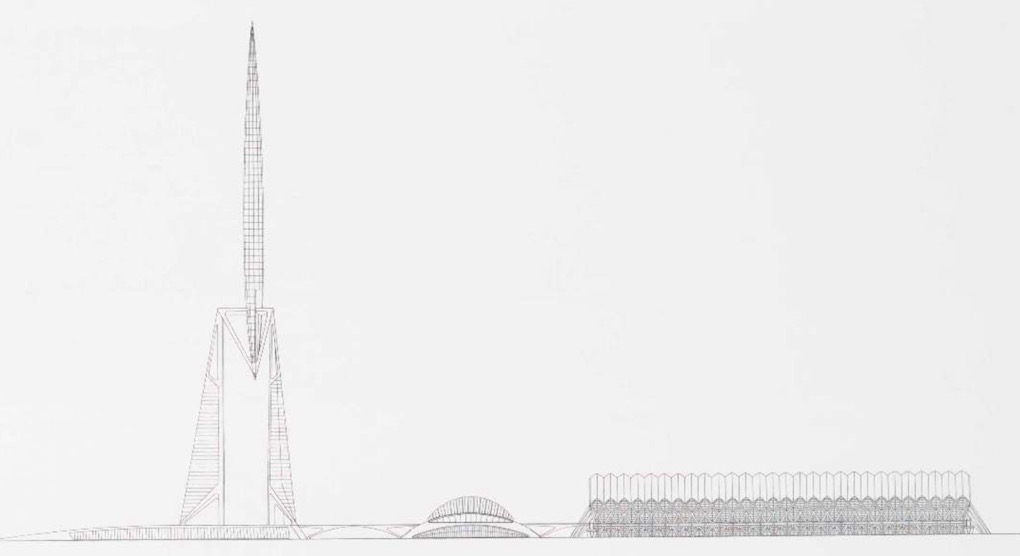
Politics and politicians change (and change again), and in 1995 the Partido Popular (PP) won against the Socialists. They announced sweeping privatisation and a review of the 'city of science'. Their idea was to invite companies like Disney and Universal Studios to invest in the project. So the PP cancelled the communication tower and museum, just keeping the planetarium (for which building contracts had already been signed). The problem was the project had already caught peoples imagination, and the 'city of science' had come to symbolise modernity.
Until the 'attack' on the project by the PP everyone could see that things had got out of hand, with pride dominating over rationality and sense of proportion. But with the arrival of the PP to power almost everyone joined together to defend the original project, and the PP's proposal to redesign the park was not well received. The general idea was that you could not replace an important cultural and educational concept with a 'theme park'. By this time the designs of Calatrava (see later on this webpage) had become the symbols of the city, and the PP was accused of wanting to 'destroy the future'.
Finally the PP backed down. They went ahead and built the planetarium and the science museum. They replaced the cancelled communication tower (the foundations were already being built) with an even more expensive concert hall (Palau de les Arts) and then added a still even more expensive aquarium 'L'Oceanographic'. By this time the party, the PP, who initially wanted to cancel everything, finally sold the idea of València and its Ciudad de las Artes y las Ciencias as "leading the regions of Europe".
This complex is actually made up by six buildings and a bridge:-
L'Hemisfèric (completed in 1998)
The Science Museum Principe Felipe (completed in 2000)
L'Umbracle (completed in 2001)
Palau de les Arts Reina Sofía (completed in 2005)
L'Oceanogràfic (completed in 2003)
L'Àgora (completed in 2009)
and El Pont de l'Assut de l'Or (completed in 2008).
The Ciudad de las Artes y las Ciencias has its own website, which provides a description of each building on the site, the exhibitions and activity programs, and ticketing information.
The "elephant in the room" is obviously the substantial over run in the construction costs, and the massive debt taken on by the city at a time when it could least afford it. At the end of this webpage I will return to this topic, but for the moment let's look at the architects and inspirational architecture of València's Ciudad de las Artes y las Ciencias.
The architects
Félix Candela
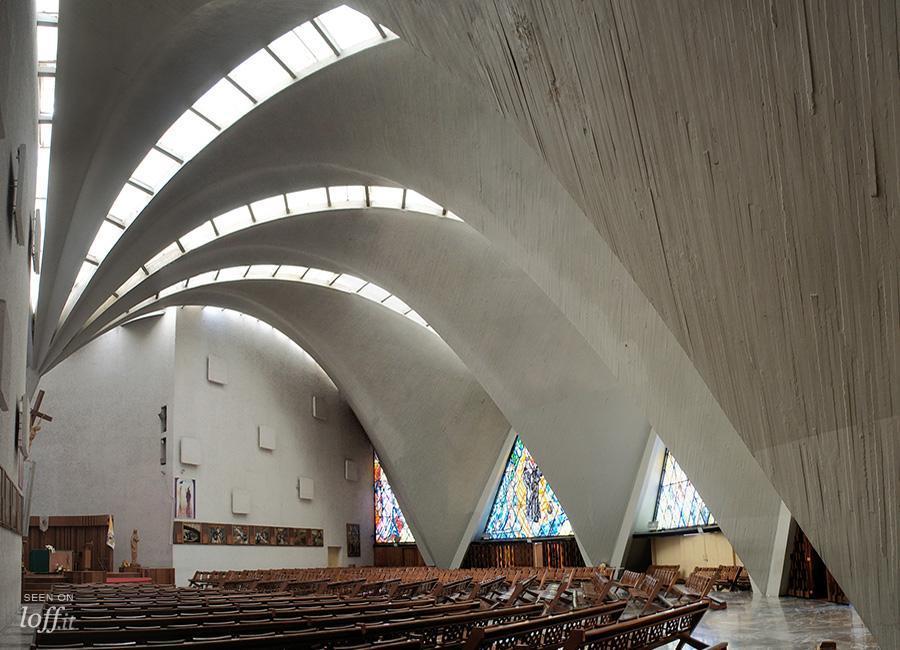
Félix Candela Outeriño (1910-1997) was a Spanish-Mexican architect who became known for the use of thin shells of reinforced concrete (known as 'cascarones' or eggshells), and later laminated structures. An example of his work is the sports pavilion for the 1968 Olympics in Mexico.
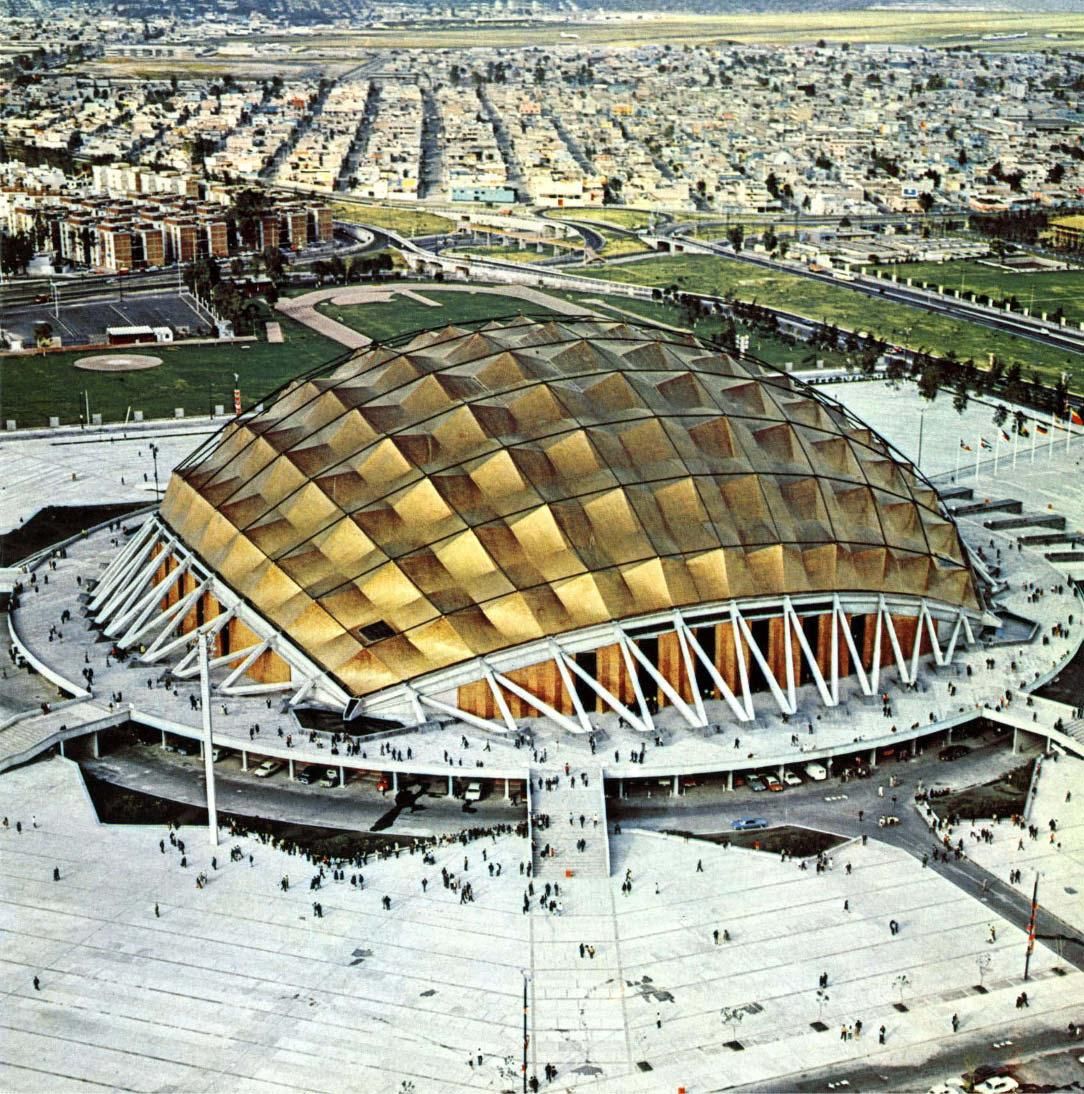
According to Wikipedia Candela had fought against Franco, was a war refugee in France, and Mexico welcomed him in 1939. There he started to engineer thin-shell concrete structures, and the company he founded was responsible for more than 800 projects through to 1976. Between 1969-1978 he turned to teaching at the Illinois University. From 1976, with the death of Franco, Candela increasingly visited Spain, and his last project was in Velència.
Santiago Calatrava
Santiago Calatrava Valls was born in València in 1951, qualified as a civil engineer in Switzerland and received his license as a structural engineer in the US in 1997.

According to Wikipedia he is best known for his bridges, however he also developed a reputation for buildings such as the Olympic sports complex in Athens (below), where you can 'see' the structural engineering at work.

You can check out his portfolio of projects on his website.
Through the early 80's Santiago Calatrava collaborated on a large number of projects involving structural engineering. For example, he was part of a team that won a competition to design four façades for warehouses in Coesfeld in Germany. Later he was work on the design of the Kuwait Pavilion for the 1992 World's Fair in Seville. He would also design the fan-shaped canopy of the Gare de Lyon-Saint-Exupéry (the railway station attached to the airport seen below).
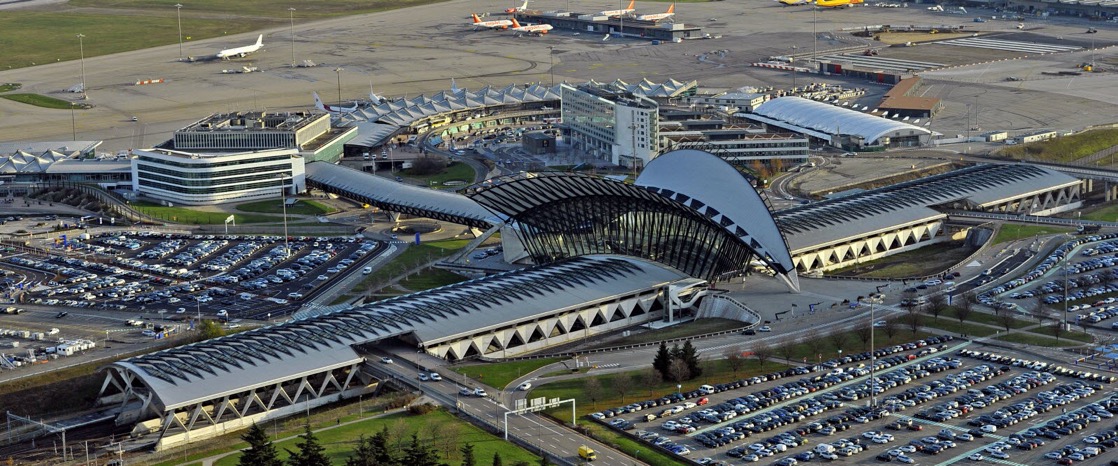
One of Calatrava's more recent commissions is the World Trade Centre Transportation Hub, in the rebuilt World Trade Centre.
City of Arts and Sciences
In 1957 there was a disastrous flood of the Turia river in València (see Great Flood of Valencia), killing at least 81 people. In the period 1961-1973 the river was rerouted south of València, leaving a 7 kilometre dried-out riverbed running through the city and down to the sea. The old river bed has been renamed the Jardines de Turia, the Green River.
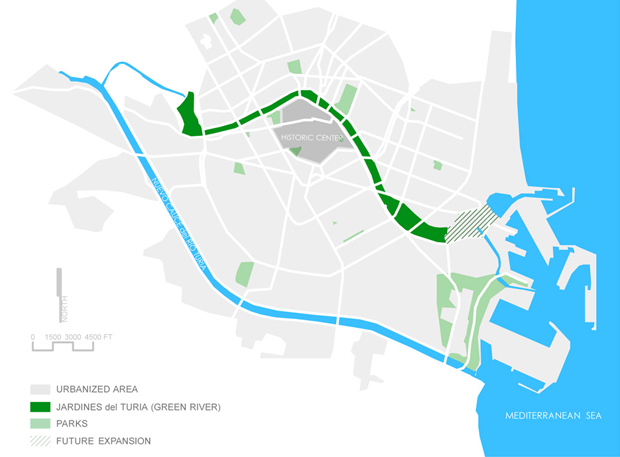
The reality was that the social and economic catastrophe of the 1857 floods left no choice to the Franco government, and the so-called "Plan Sur" was approved 9 months later. The task was to create a 12 kilometre long canal (175 metres wide), capable of draining 5,000 cubic metres of water per second. This involves creating a new 'mouth' into the sea, and changing a substantial part of the network for drinking water and sewerage (not to mention roads, bridges, etc.). Approved in 1961, the work started in 1964 and terminated in 1973 (they never fully completed the initial plans). The canal itself was completed in 1969 and involved 1.4 million cubic metres of concrete and 3 million tons of stones the line the bottom. On the other hand the city gained 110 hectares of the river bed, running through the centre of the city. Initially the idea was to run the railway and motorway through the river bed, but a very effective campaign emerged called "El lit del Rio es nostre I lo volem ved" (the river bed is ours and we want it green).
In 1991 Santiago Calatrava was responsible for a winning proposal to build a telecommunications tower in València. The site was in the dried-up river bed. He subsequently received a commission to develop a complex of three buildings to be called 'The City of Arts and Sciences'. The idea was to have an elevated central walkway that would link the telecommunications tower at one end with a long-ribbed science museum at the other end. In the middle there would be a planetarium where the roof could open and close. After a change of government in 1996, the planned telecommunication tower was replaced by an opera house.
In 1987 Calatrava had already been commissioned by the Junta de Andalusia to build a bridge to span the Meandro San Jeronimo in Seville. The occasion was the 1992 World's Fair and the result was the 200 metre long Alamillo Bridge, which immediately became a landmark.

Quickly an underwater 'city' (L'Oceanogràfic) was added, and Felix Candela was commissioned. The client for this was the government of València, and in fact worked started first on this building.
Before looking at each building let's try to get a feel for the whole site. Below we have different views of the entire site, i.e. a street view, a couple of 'tourist' plans, and two aerial views.
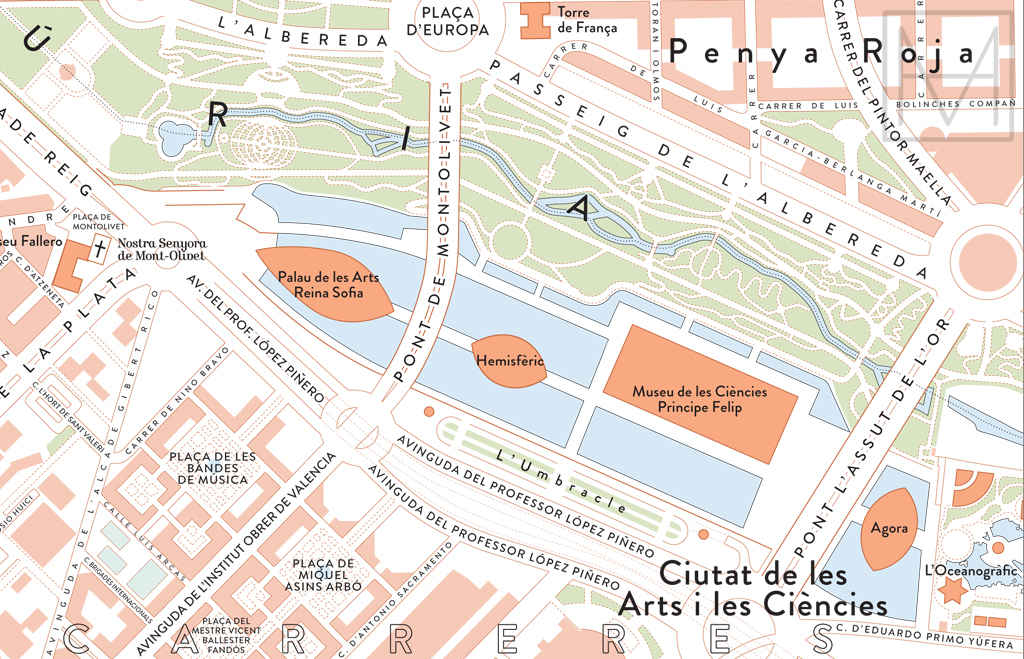


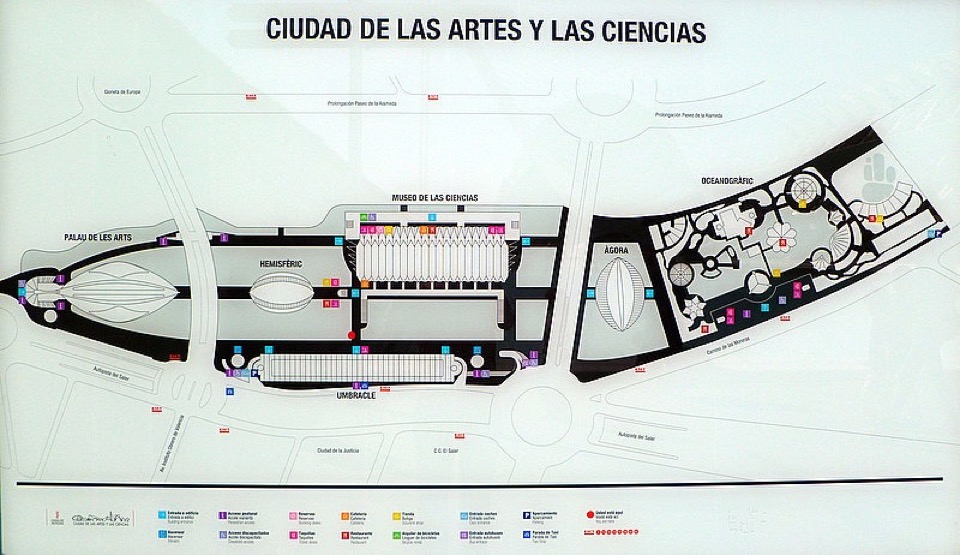

L'Hemisfèric
This planetarium was designed by Calatrava, and although it was not the first building started it was the first building opened in April 1998. In many ways it is the centrepiece of the entire complex.

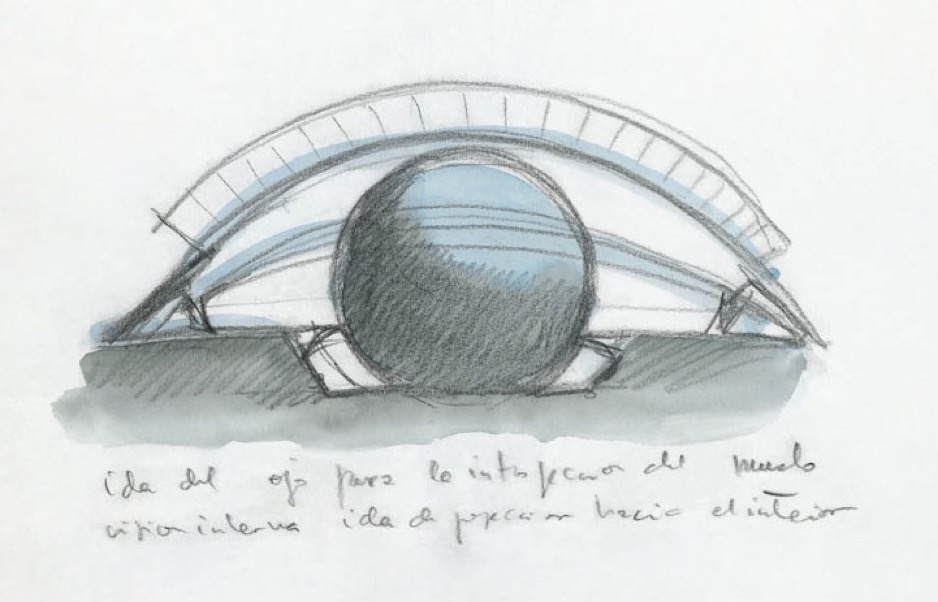
The building is meant to resemble a giant eye, and is also known as the 'Eye of Knowledge'. You can see from the initial designs of Calatrava that the inspiration for the concept of this building was very explicitly the human eye.
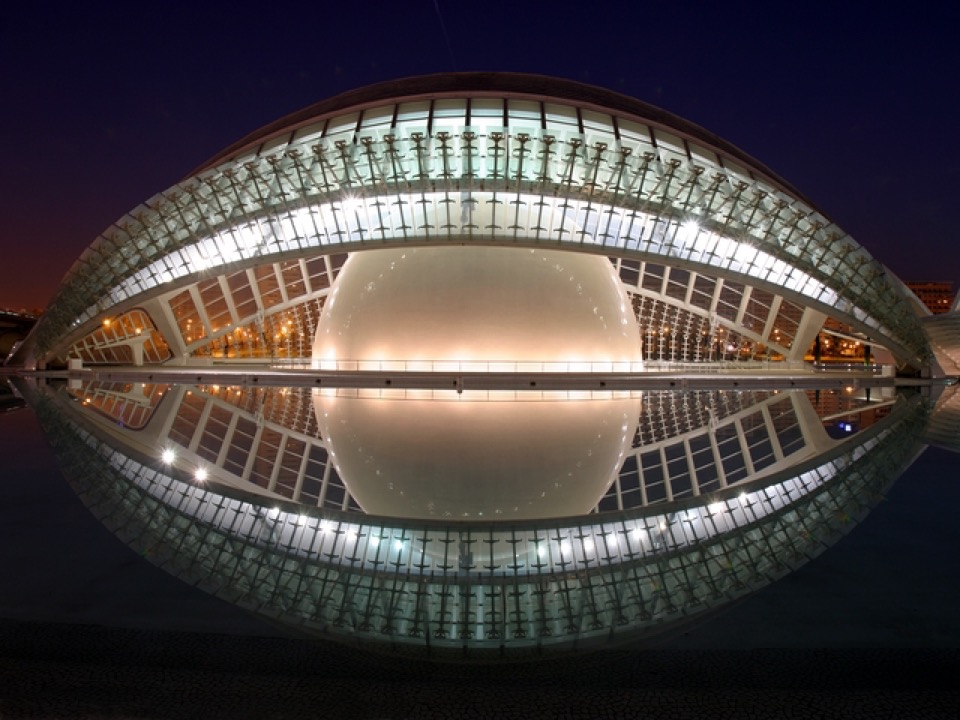
The whole shape of the eye is completed by a mirror, in the from of a surface of the water. The building is surrounded by a water pool, and the bottom of the pool is made of glass.
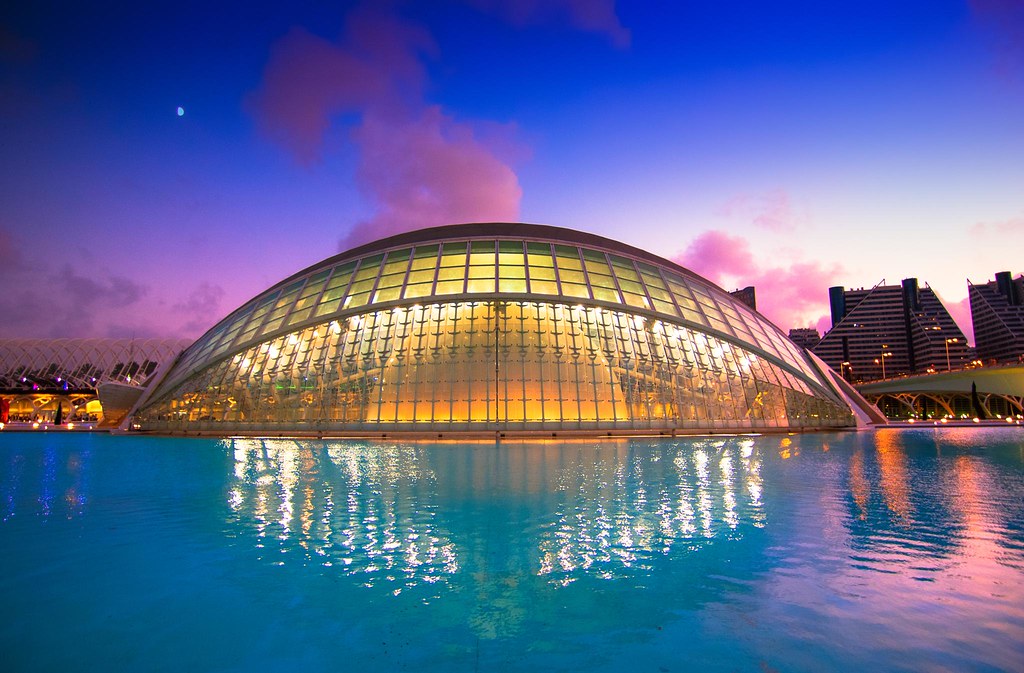
What you have in fact is a kind of 'eyelid' made up of two parts that open and close, and also serve as a shade-shutter (above the 'eyelid' is closed, and below it's open).
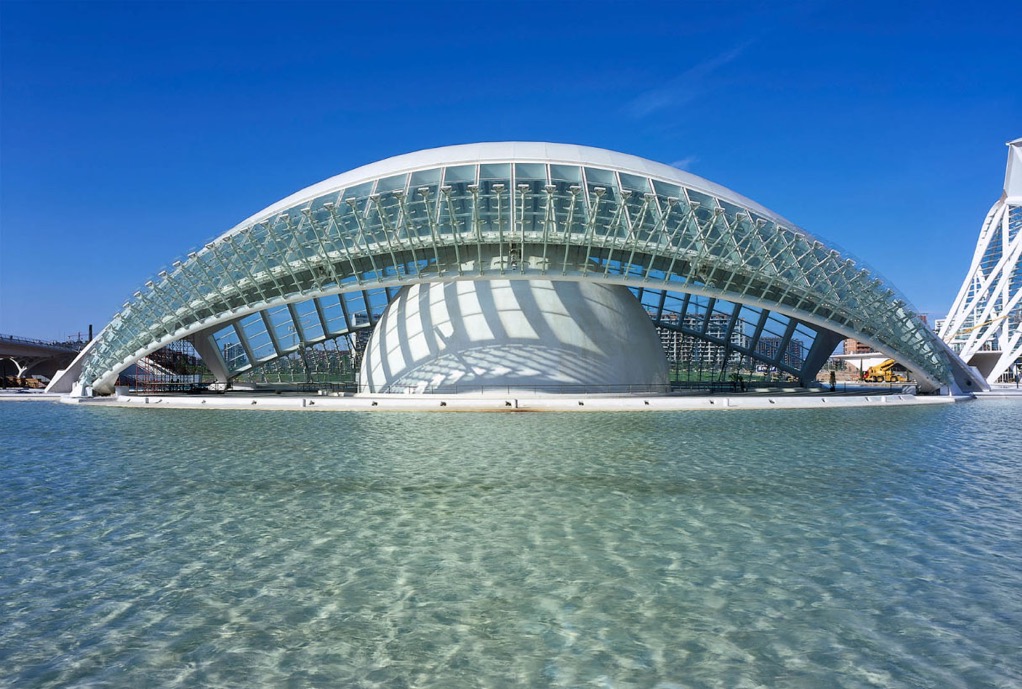

The structure of the 'eyelid' is aluminium and we can see the dome that is conceived as the pupil of the eye. Below we have the entrance.
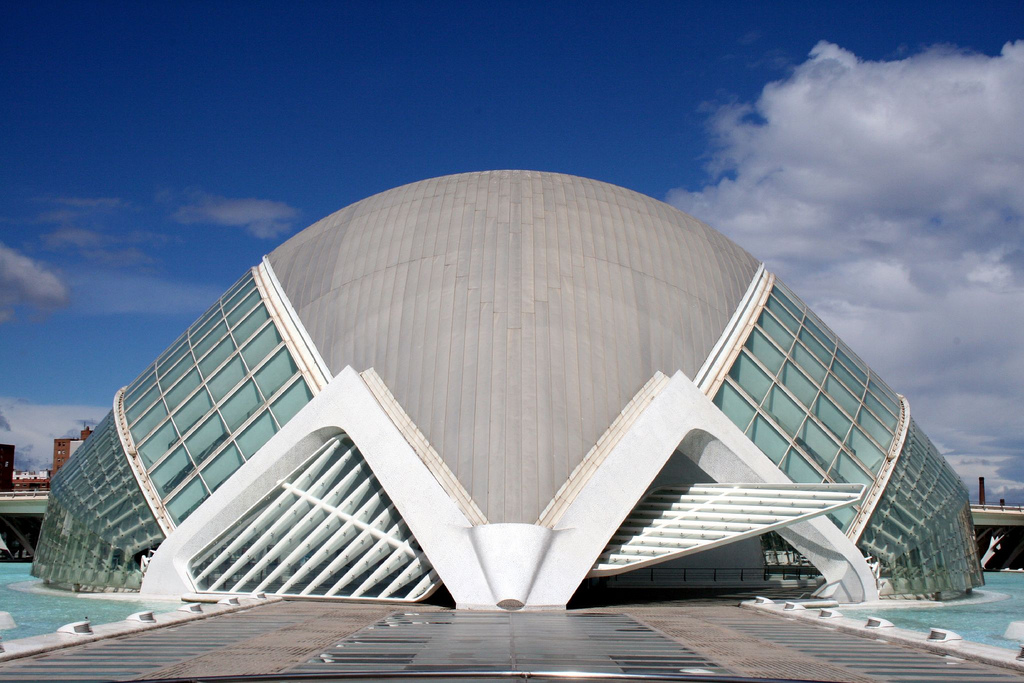
In 'the dome' itself is an IMAX cinema, the planetarium and a Laserium. This planetarium is a half-sphere composed of concrete, 110 meters long and 55.5 meters wide.
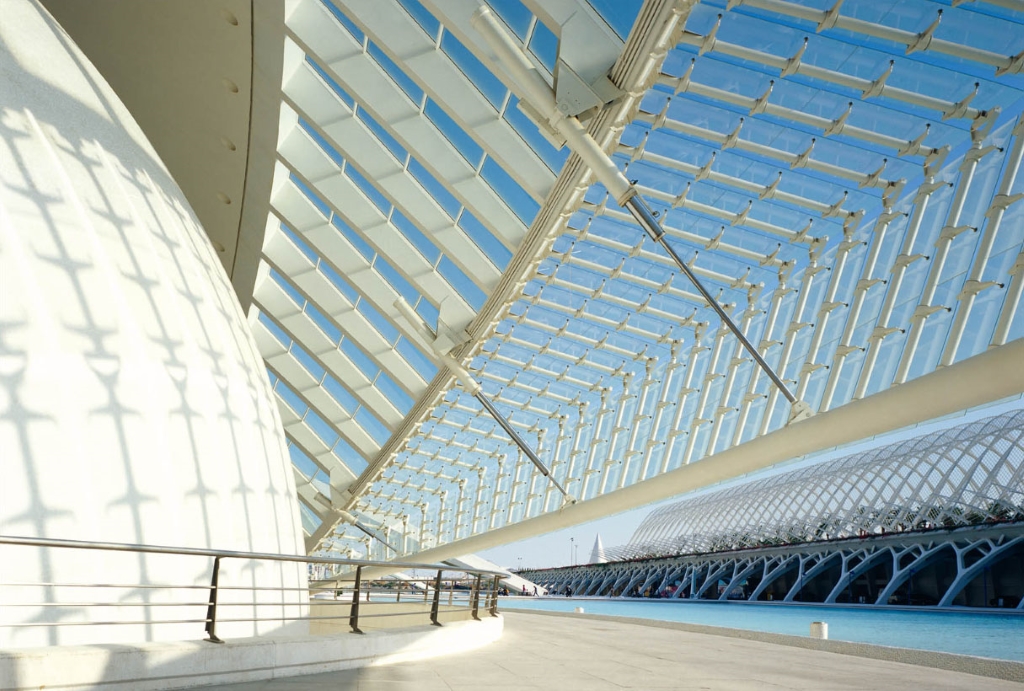
The below photograph works to situate the planetarium with respect to the other buildings on the site.
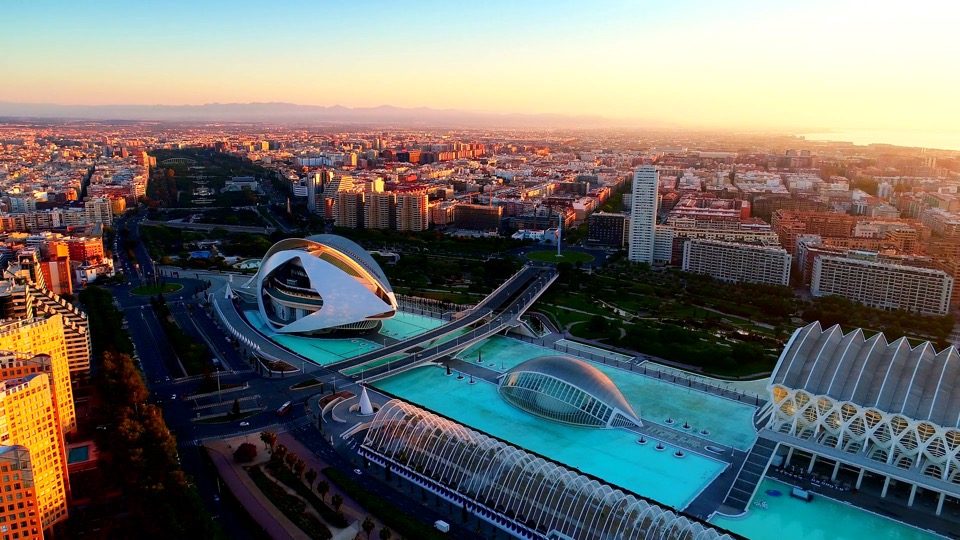
The Science Museum Principe Felipe
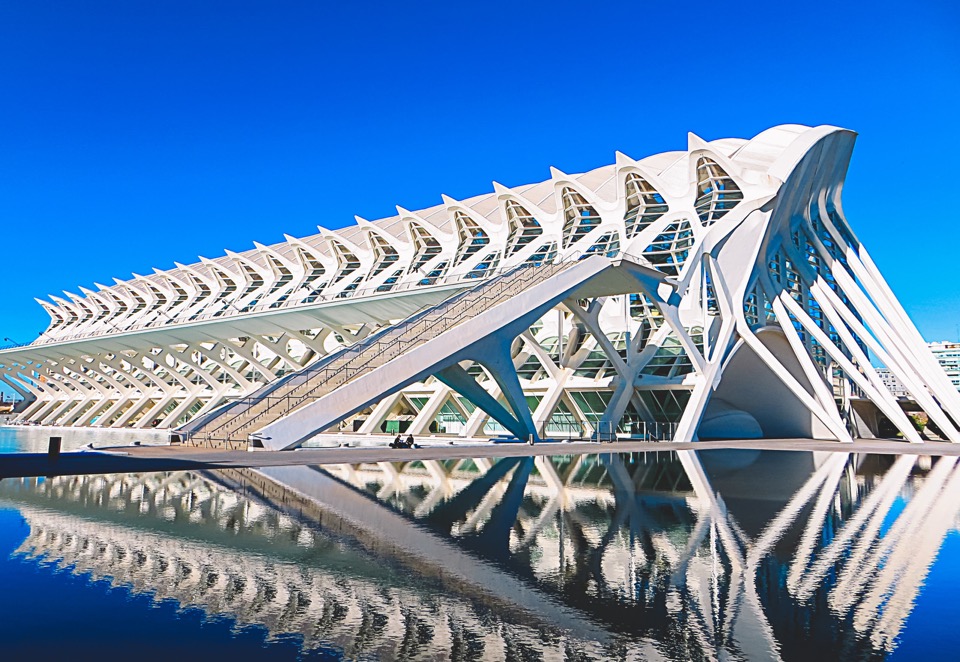
The second building on the site is The Science Museum Principe Felipe ('Museu de las Ciències Principe Felipe'), which was also designed by Santiago Calatrava.
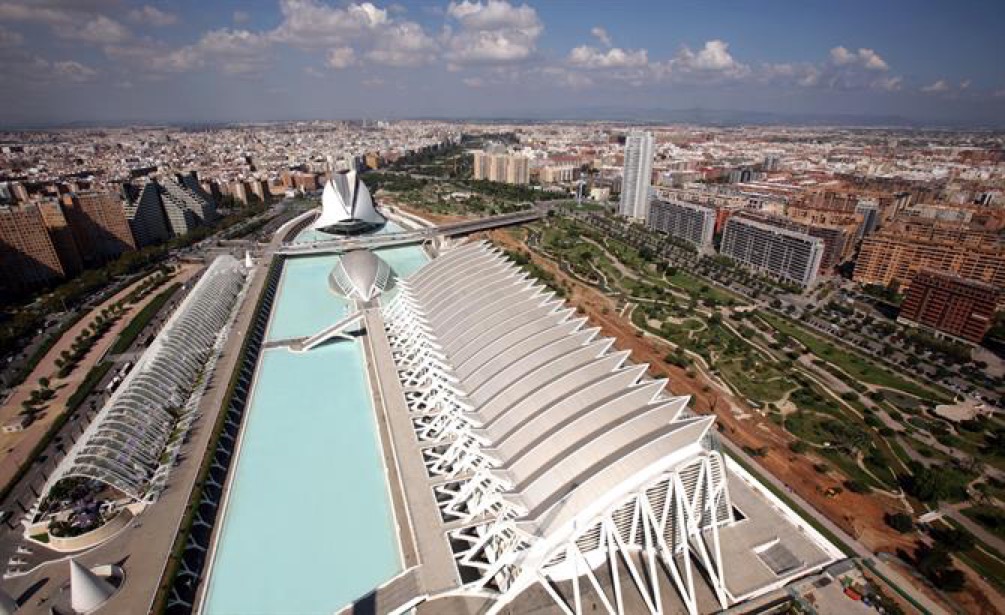

The shape of the building resembles the skeleton of a whale. This prehistoric skeleton is designed by the repetition of the one element, which acts as a structural module or 'primitive' that is repeated along the entire length of the building.
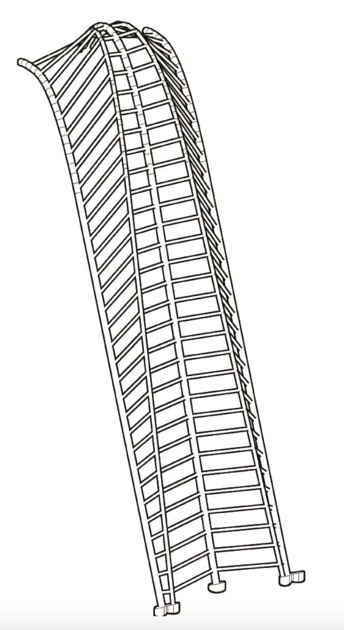
The symmetrical ends of the building are braced firmly by triangulated structures which also mark the entrances.
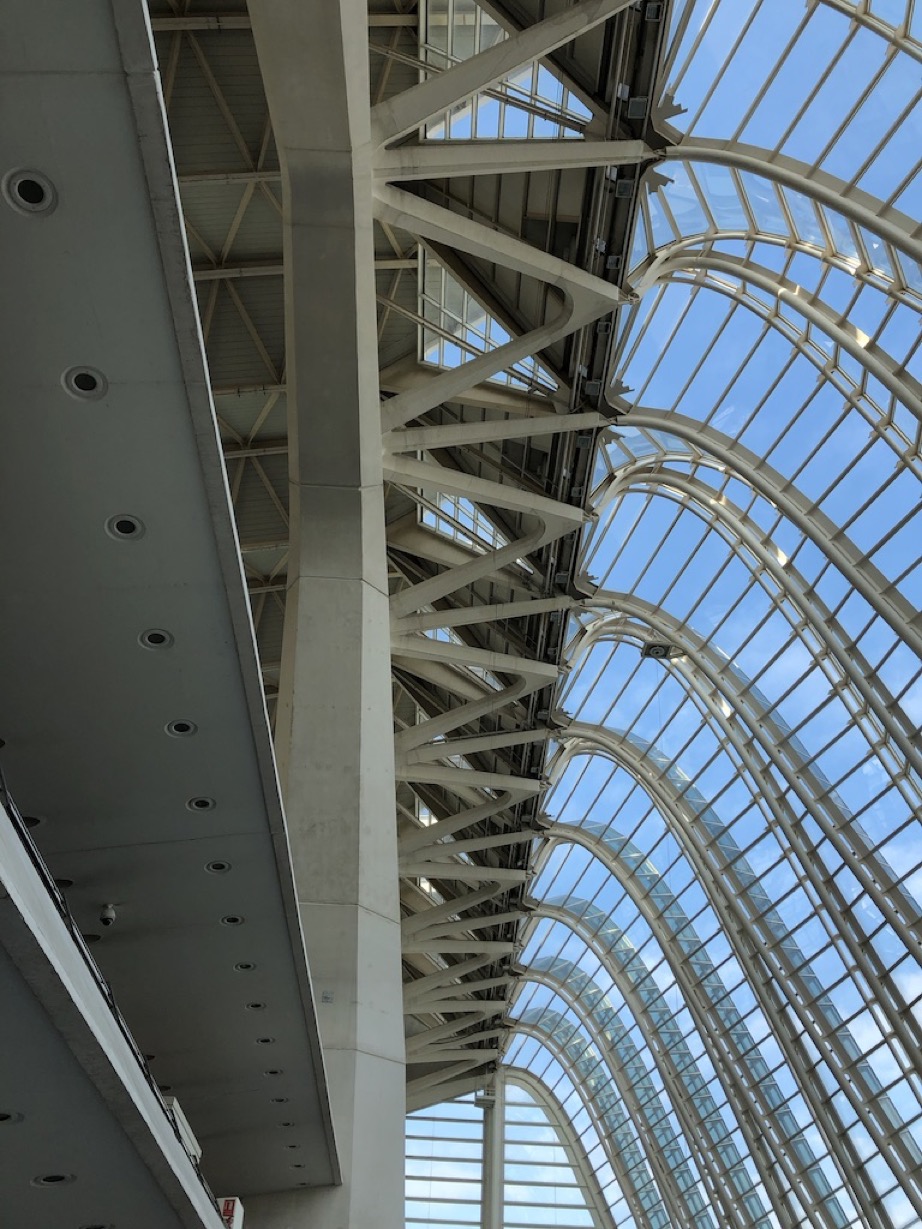
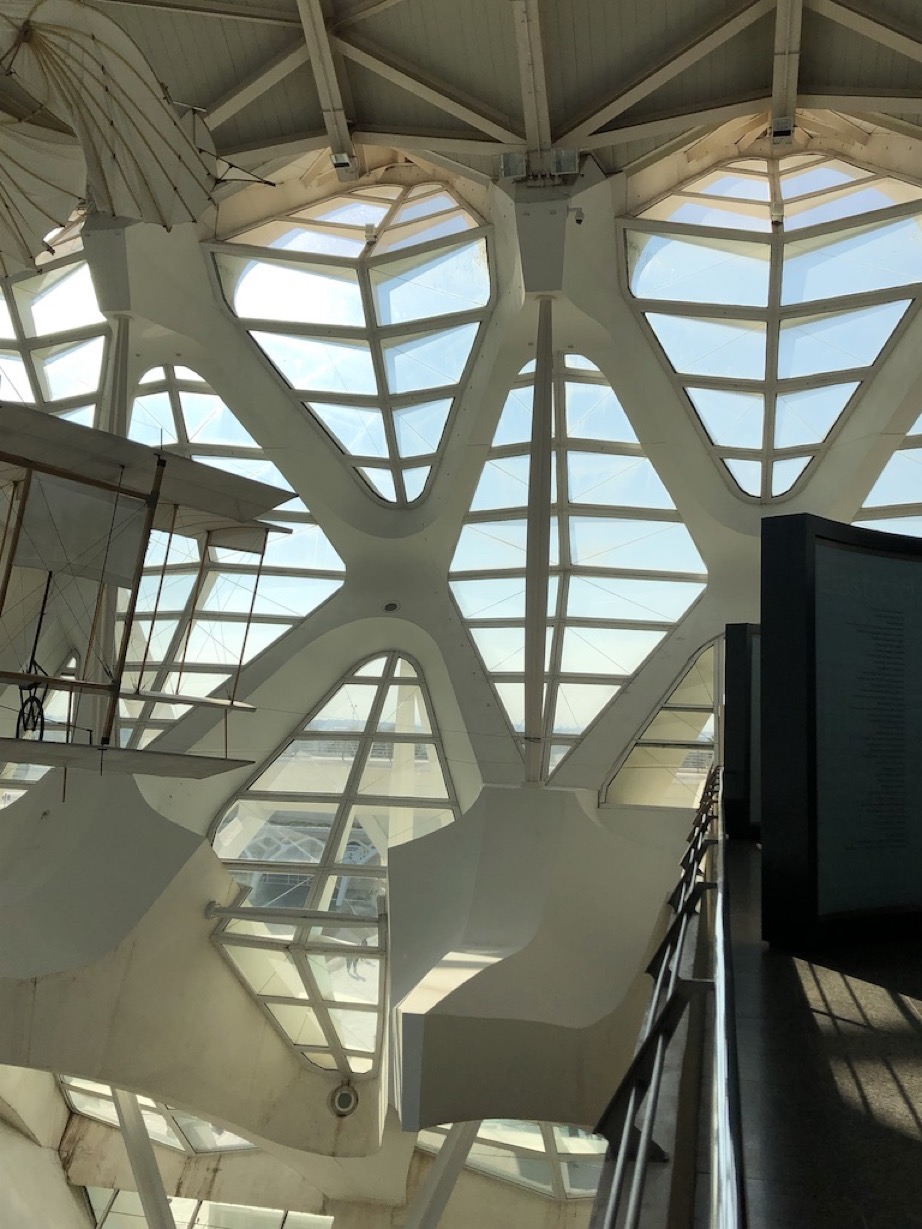
The building was designed in 1991-1995 and completed in 2001. It covers a single space 220 meters long, 80 meters wide and 55 meters high, with a surface area of around 40,000 square metres on three floors (about 26,000 square metres are used for exhibitions).
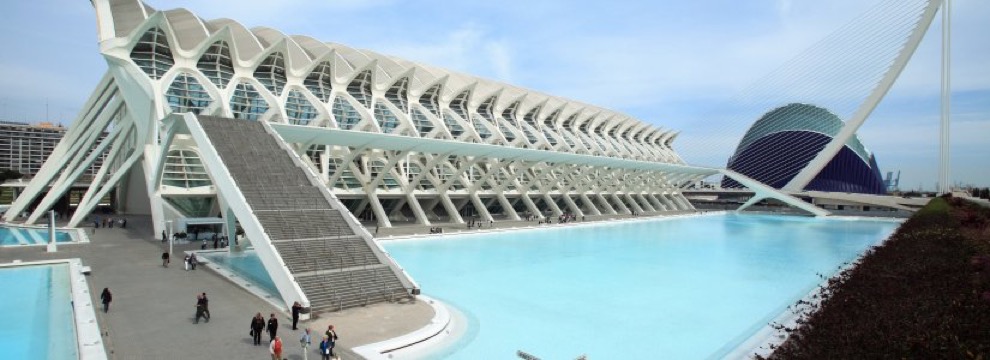
Structurally the building is composed of white concrete for the skeleton, and a skin of glass with a steel support structure. The entire white supporting concrete framework of the south-facing façade is filled with glass.


The north-facing facade (above) is a glass and steel screen that forms a continuous curtain also along the full length of the building.

The interior space is supported by five concrete 'trees' (above) which supports the link between the roof and the façade and permits the integration of service cores and lifts. Below we can see how the different exhibition spaces are created with the skeleton.

The website of the museum explains the different exhibitions. When we visited the museum we were particularly impressed by the one on Mars and 'Explore Your DNA' (which was later replaced by a new exhibition on the human brain and memory).

Palau de les Arts Reina Sofía
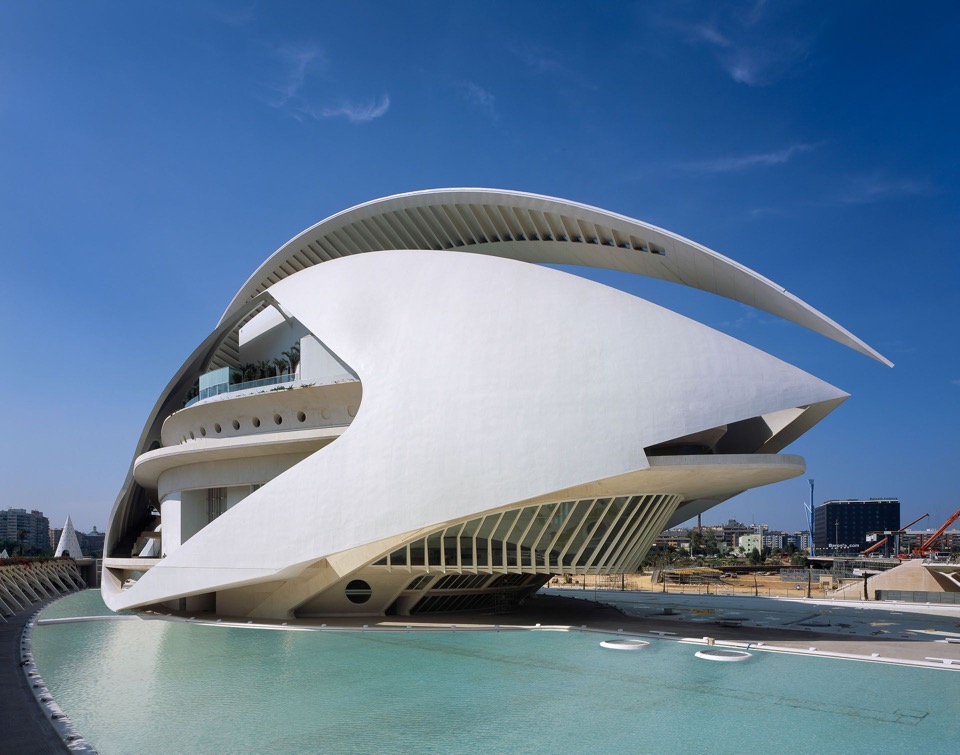
The Palau de les Arts Reina Sofía, also designed by Santiago Calatrava, is a multi-hall auditorium, or "opera house". This is considered the most important building in the complex, and the aim was to create a kind of monumental 'landmark' for the entire site, a symbol for the entire city. It was designed to impress, at 75 metres high it was the tallest opera house in the world. The Sala Principal (Main Hall) had one of the largest stages in the world, and the third largest orchestra pit in the world (not sure what the situation is today). Check out Les Arts to get an idea of what they offer, and some of the videos are really interesting about the building and what it looks like.
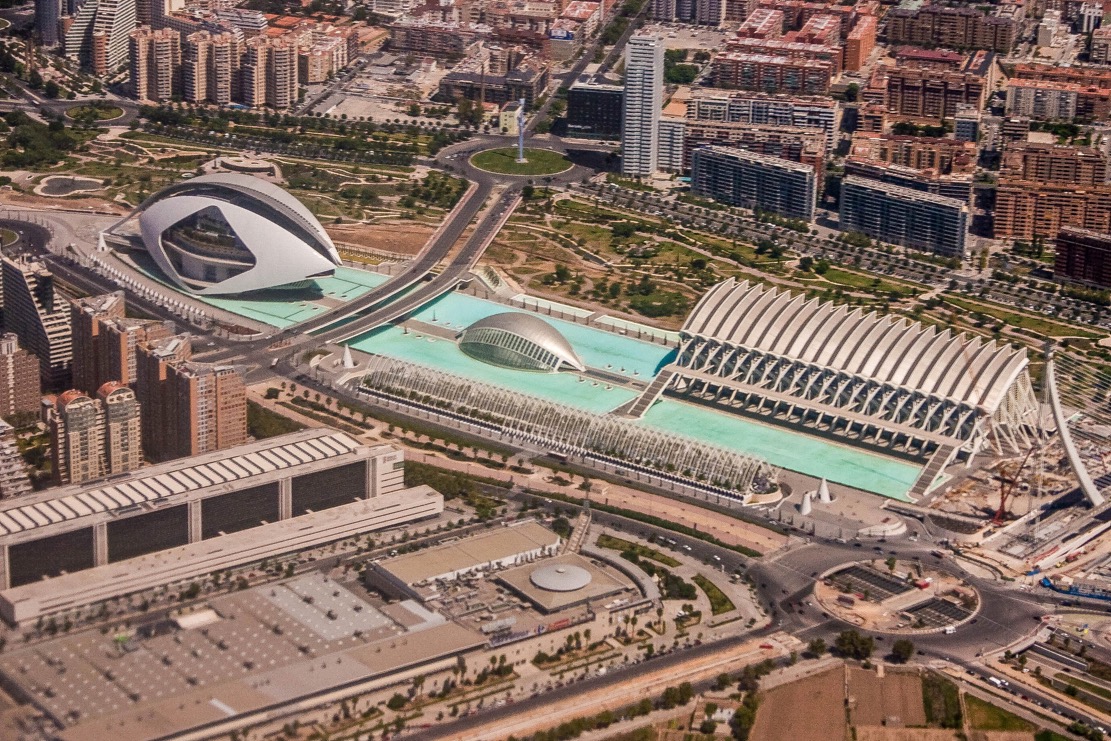
The opera house is situated to west, along the axis that runs through the entire complex, and it is one of the three buildings that are aligned, forming a kind of progression, but each having their architectural merits. To call it an opera house detracts from it more general objective to provide a place for music, dance and theatre. The 'look' can be called many things, but a "ship run aground" is the one that most people mention.
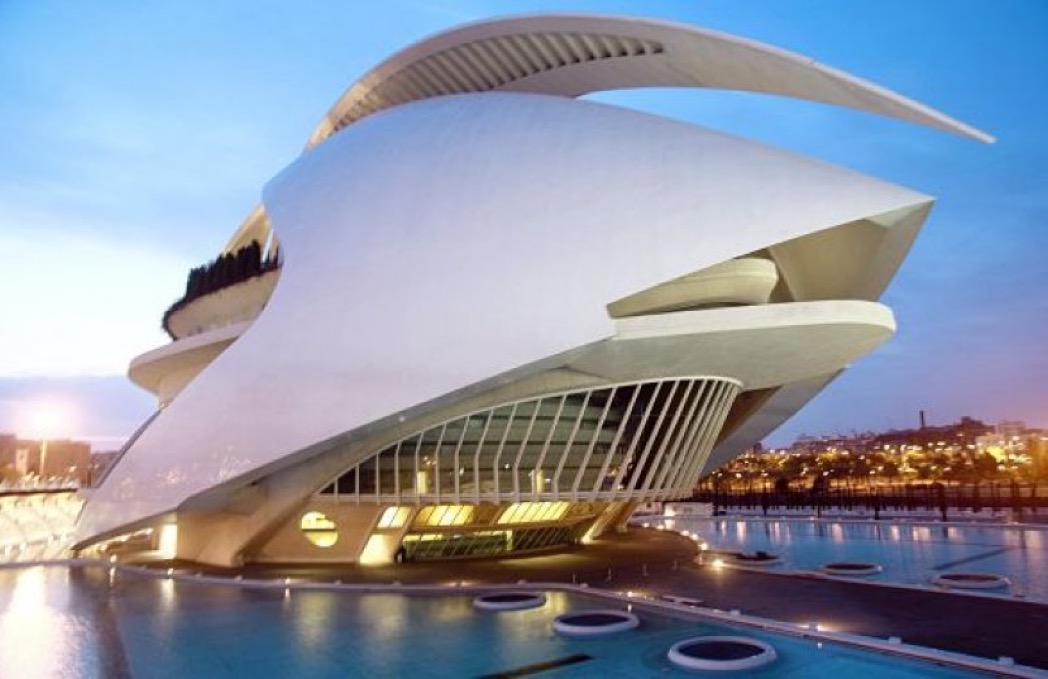
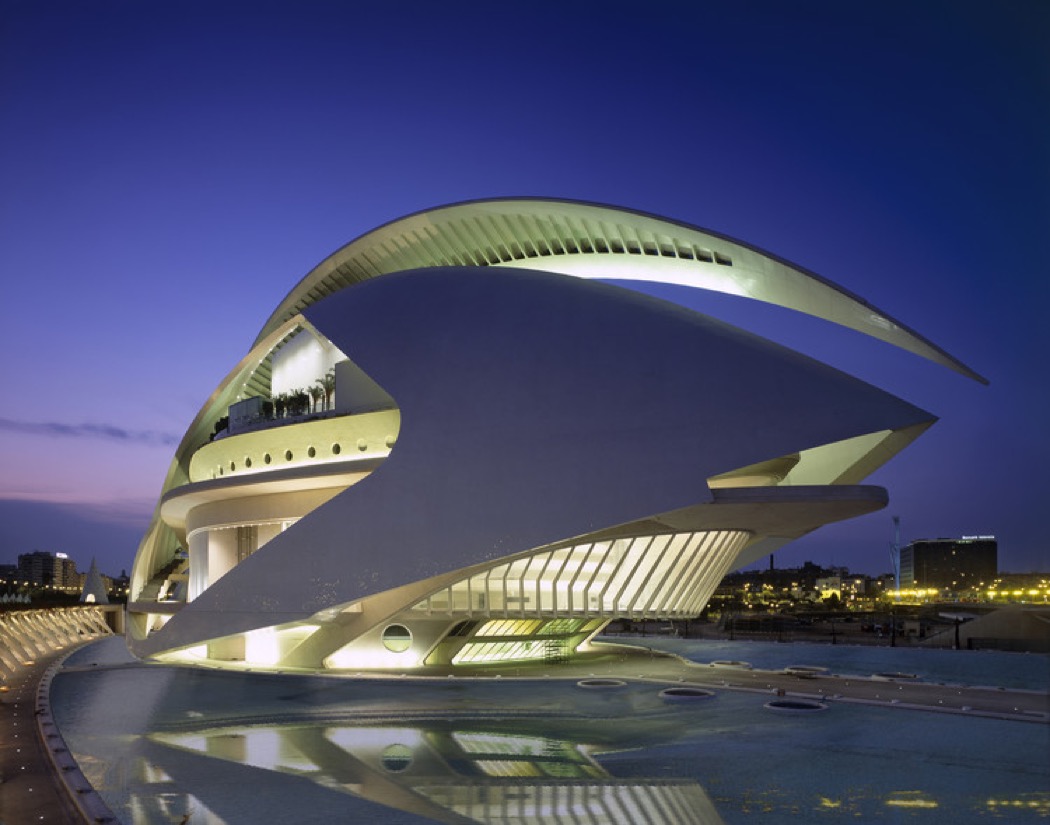
Let's first have a look at the overall design of the building. The building is really made up of four parts. Firstly, what you might call the 'inside' building, then two exterior shells segments, and finally a 'plumed feather' structure that floats over the entire construction. Each component was conceived to share the same surface material, creating a smooth, virtually seamless and glowing white appearance. The basic structure is in white concrete, and laminated steel cladding is used on the plumed feather. The two shell segments and the plumed feather are actually disconnected from the building, so they are just architectural decorations. In this sense the building looks complex, but it is in fact a rather conventional building housed inside a complex decorative façade (literally).
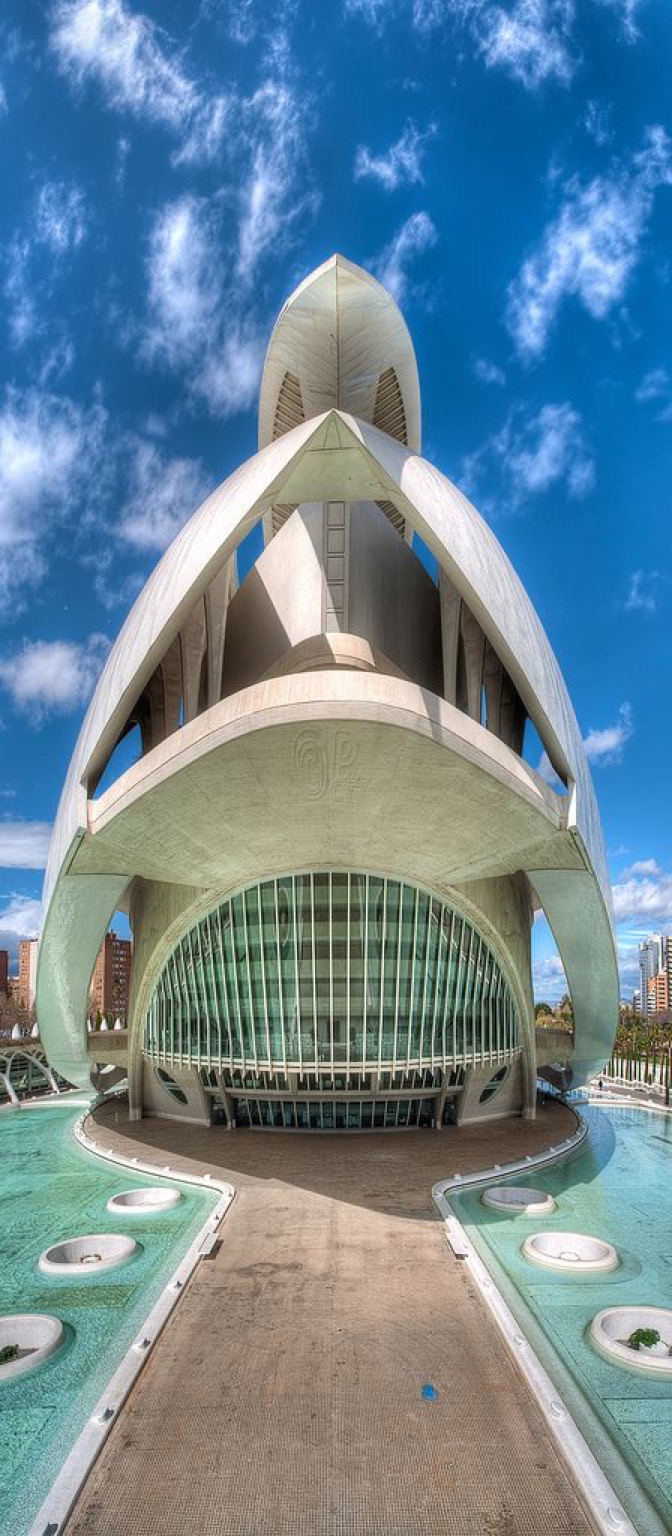
The most characteristic parts the building are the two laminated steel shells that hug it, and the roof 'boom' or 'plumed feather'. The building sits on a curves space 163 metres long and 87 metres wide. The 'boom' is in fact 70 metres high and 230 metres long, whereas the two shells, weighing about 3,000 tons, are covered in a delicate ceramic tile called "trencadis".
The building consists of 10,000 of structural steel, 20,000 tons of corrugated steel, 77,000 cubic metres of concrete, 20,000 square metres of tiles, 38,000 square metres of granite, and 3,360 square metres of glass, for a total dead weight of about 242,000 tons. You can then add another 20,000 tons if you count equipment, furniture and fittings, etc. and fill all four halls with people. So that's nearly 270,000 tons on a relatively small footprint, yielding a charge of 70 tons per square metre (which is much higher then in normal residential and small commercial buildings). What this means is that most of the structure engineering is just to support the dead load of the building and not the live load of its contents. These considerations, and also remembering the location is near the sea, meant that the building needed to be build on deep piles (in fact a total of nearly 1.8 kilometres of piles were used), which involved the removal of 265,000 cubic metres for the foundations.
Another interesting aside is that assuming the building is full with approximately 4,000 spectators and performers, it will be generating nearly 2 MW of thermal energy, that needs to be cooled. All the more so when in the summer the temperature can easily exceed 30°C. So adding this together means that the building needs more than 700 tons of refrigeration, which corresponds to a total energy requirement of over 10 MWh. At today's prices that over €1 million annually in just air-conditioning.
The buildings 37,000 square metres are distributed over four large halls, i.e. the Main Hall (Sala Principal), the Amphitheatre (Auditorio), the Master Classroom (Aula Magistral), and the Chamber Theatre (Teatre Martín I Soler). In addition there are the usual vestibules, meeting rooms, etc. as well as an exhibition space.
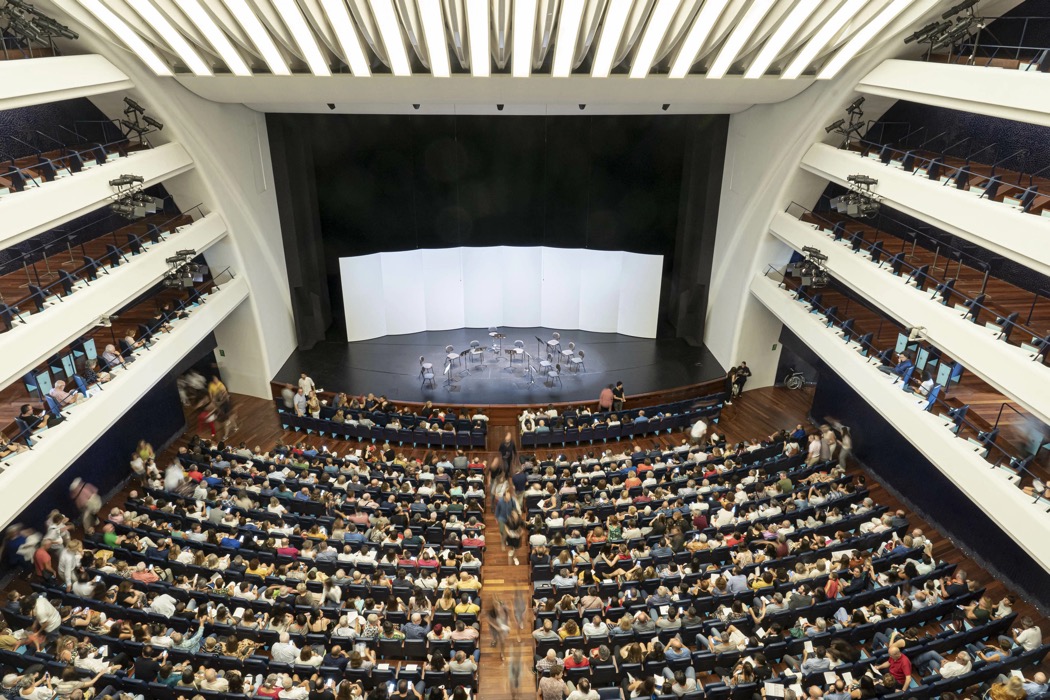
The largest space is the Main Hall (La Sala Principal) with a capacity of 1,412 spectators, and, with the opera boxes, this hall is most reminiscent of an opera hall.
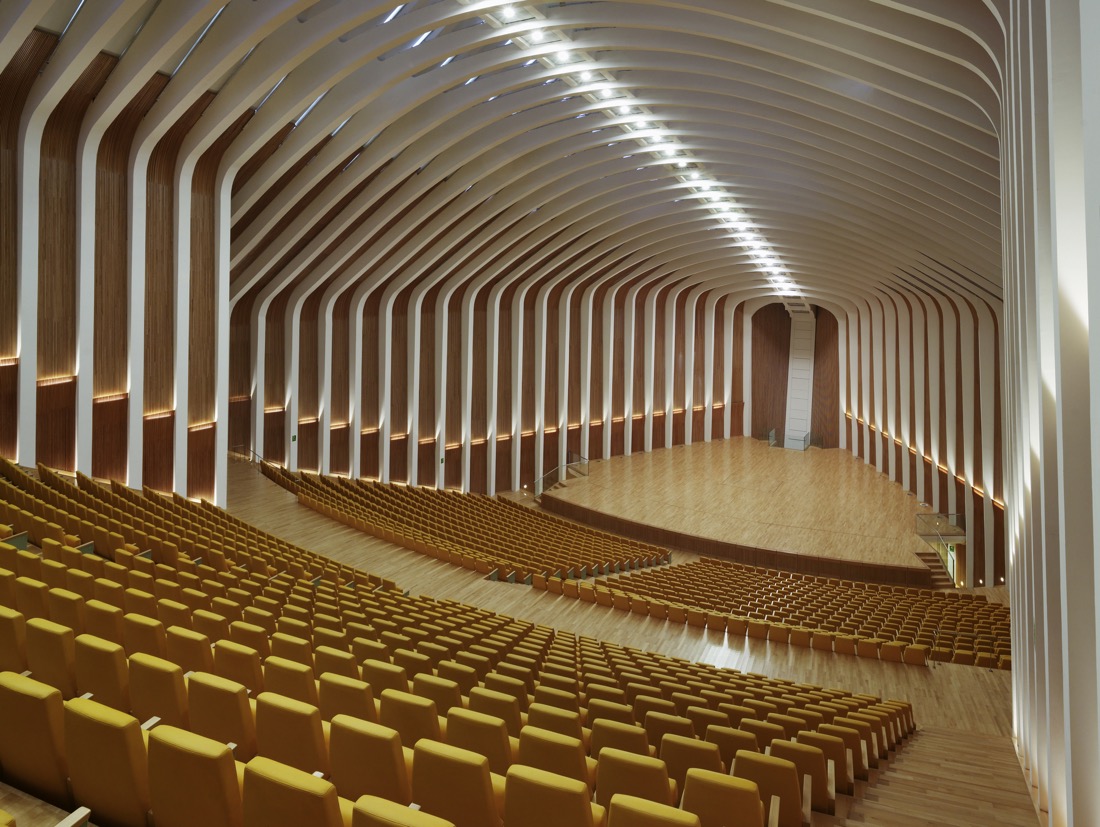
The next largest space is the amphitheatre with a capacity of 1,500 people, and its equipped as a radio-visual platform for film, video, etc.
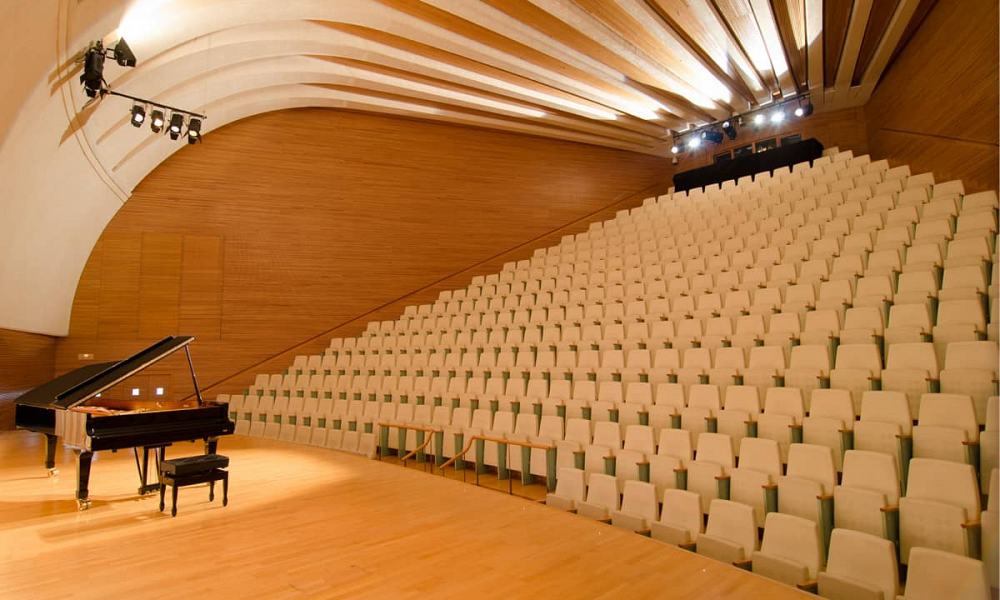
The next hall is the Magistral Room, with a capacity of 400, most aspired to musical groups, conferences, etc.

The last hall, the Martín i Soler Theatre, is for the applied arts, dance, exhibitions, etc., and also can accommodate 400 people.
Whilst it is true that the actual building is far more conventional than the shell and 'plumed feather' would suggest, nevertheless the distribution of the four mail halls is very astutely designed in terms of separate accesses and services, etc. Below we can see the lower floor area is composed of the Main Hall and the Magistral Room, and the upper floor is home to the amphitheatre and Martín i Soler Theatre.


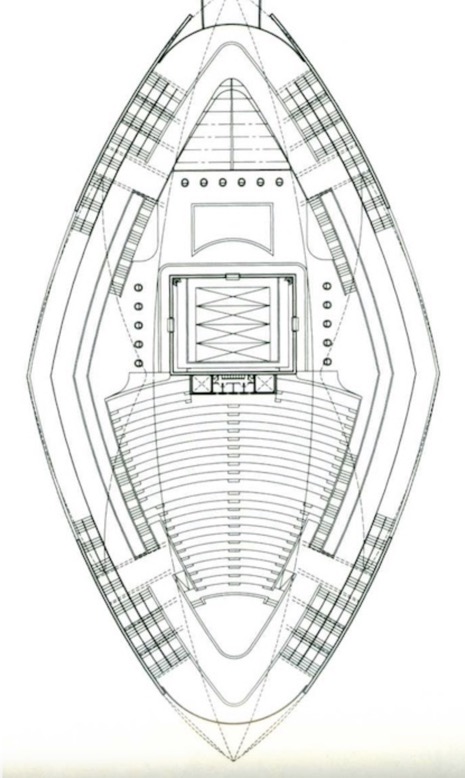
The reality was that Calatrava's €478 million building was not perfect in all its details. After the grand opening in 2005 the building remained closed for one year. It would appear that in 2006 the entire stage caved in. In 2007 the entire premises were flooded, because it was built in a former riverbed. One report noted that still in 2014 one of the four opera halls had never been used, and another had 200 seats removed because they could not see the stage properly. Another report (which I have not bee able to confirm) mentioned that one of the halls had a problem of acoustics because the walls were made of mosaic tiles, which one person said "it sounded like being in a public toilet".
In 2013-2014 the 8,000 square metre exterior made up of 1,000's of small mosaic tiles looked the worse for wear (after having been ripped by high winds). Naturally some of the press went to town with "White Elephant Opera House Falls Apart". The idea was to use "trencadís", a kind of ceramic mosaic made from tile shards, first used by Gaudí and other Catalan modernists. However a report commissioned by the Generalitat claimed that this was due to a design flaw and incorrect choice of materials, and 60% of the tiles adherence was failing. So it the tiles worked for Gaudí but not for Calatrava. The solution was to remove the tiles and simply paint the building white. Another problem was that the metal dome and ceramic covering have different coefficients of thermal expansion and given the noticeable temptations variations in the region, the result was the appearance of lumps and wrinkles.
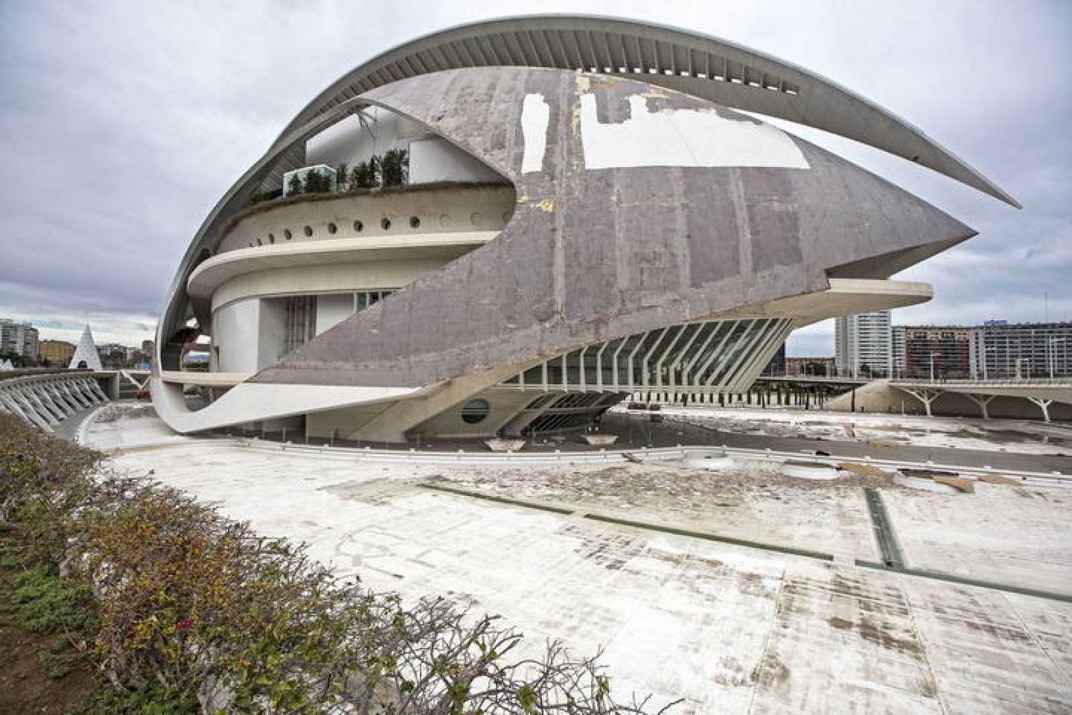
In 2015 the solution, organised by Calatrava, was to replace the tiles with a different adhesive, with the reminder to periodically inspect the tiles to ensure that there were no further problems.

L'Ocenaogràfic
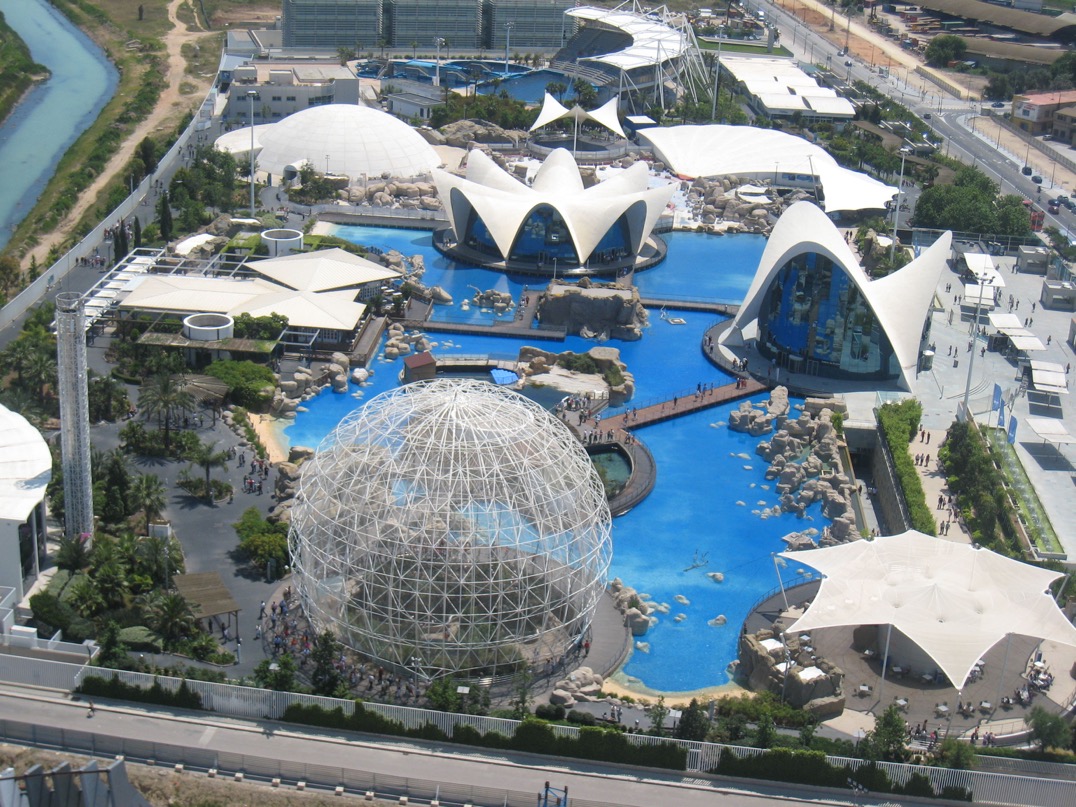
The l'Ocenaogràfic is a 110,000 square metre oceanarium designed by the architect Félix Candela. So the idea is to present an ocean habitat with marine animals, and I think it is still the largest complex if this type in Europe. Some people have suggested that the authorities wanted a cross between a classical aquarium and an American-style theme park. The physical plot was somewhat limited for a theme park, so the solution was to build a number of the 'themes' and services underground, leaving the ground level for landscaping and restaurant options. For example underground there is an additional 15,000 square metres for water treatment and maintenance access to the aquariums, which in most cases are also underground.
The figures are impressive with 45,000 animals from 500 different species living in 42 million litres of water. The salt water is pumped from a local beach, having passed all the necessaries quality tests. There is not much to add in terms of activities, and it best to check out the website for more details. I can only say we had a great day out there, and its well worth a visit.
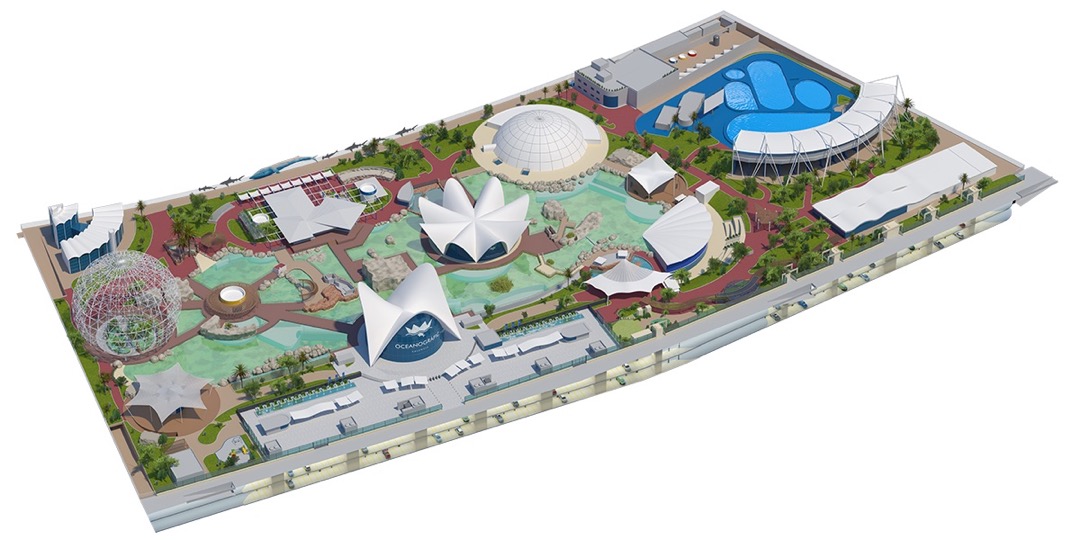
Above we can see the basic layout of the site, and below I have found on the web a nice set of expanded views.

Above we can see the entrance building with the site name on it, and bottom left the Mediterranean area. The big sphere is the wetlands/Avery, and the dark brown part in the middle is the temperate/tropical area. The seals are in the lighter brown area, and at the back there is the restaurant and terrace area.
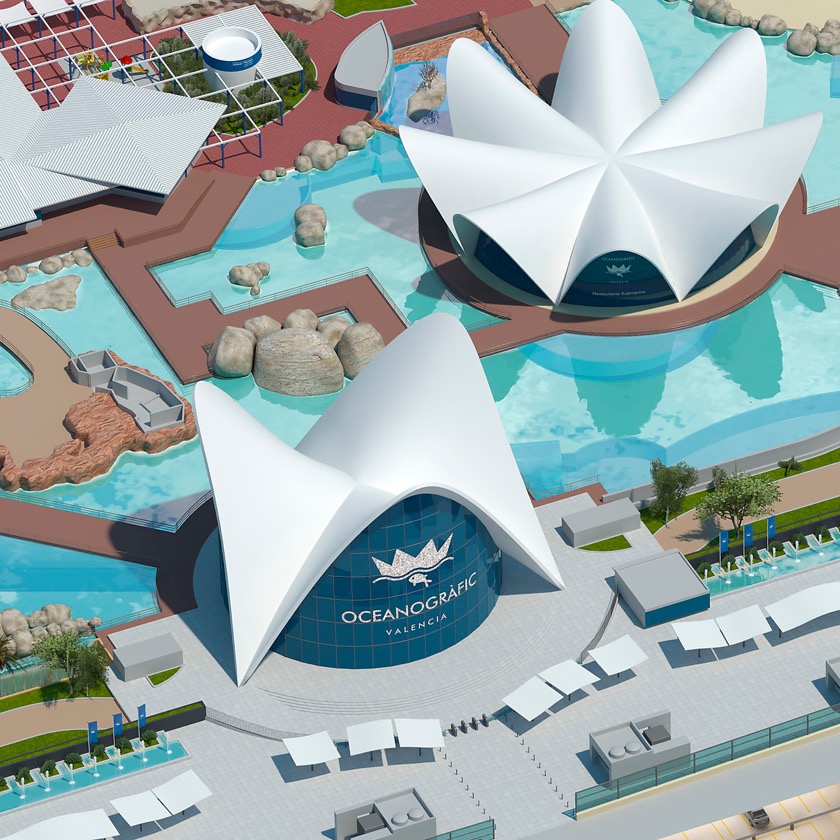
Above we have again the main entrance, and the large building is the submarine restaurant, with just behind it the area of the crocodiles.

Above we have upper left the artic area with the belugas, Central left there are the flamingos, and bottom left we have the sea lions and the Red Sea and 4D cinema. In the middle there is an area dedicate to penguins, and on the upper right we have the delphinarium.

Below I've collected together a few photographs that I hope capture the quality and extent of the offer, because it is truly a great day out and full of interesting options. We did not even have time to try out the restaurants, so no reviews.

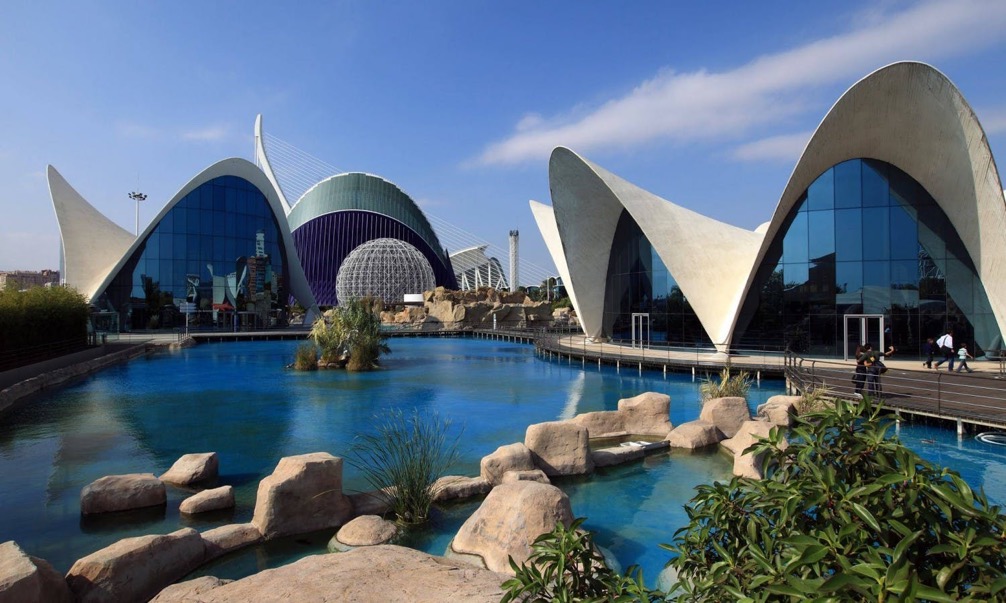

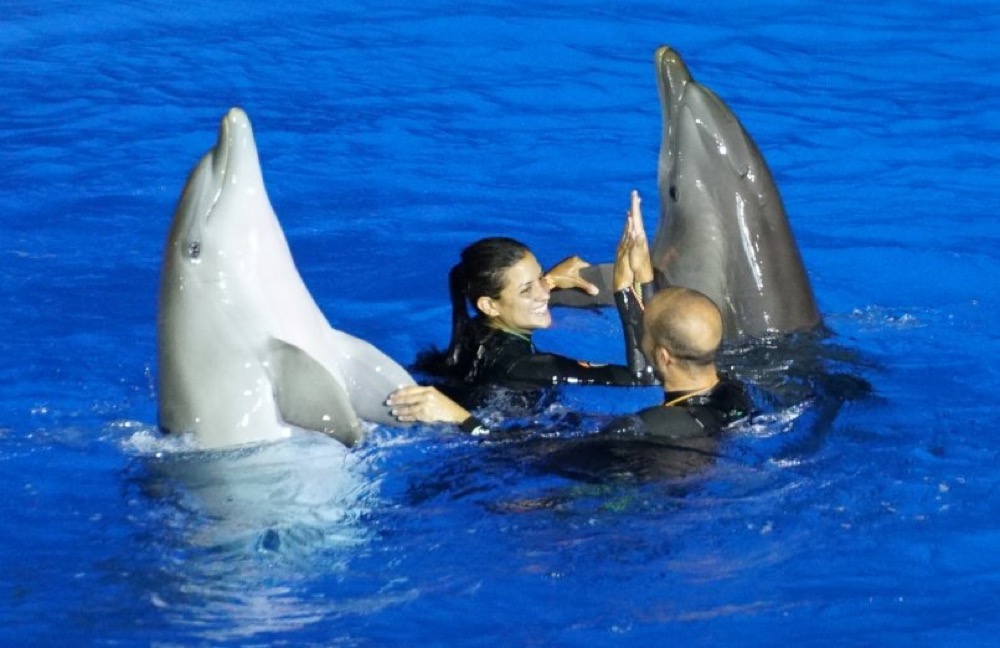

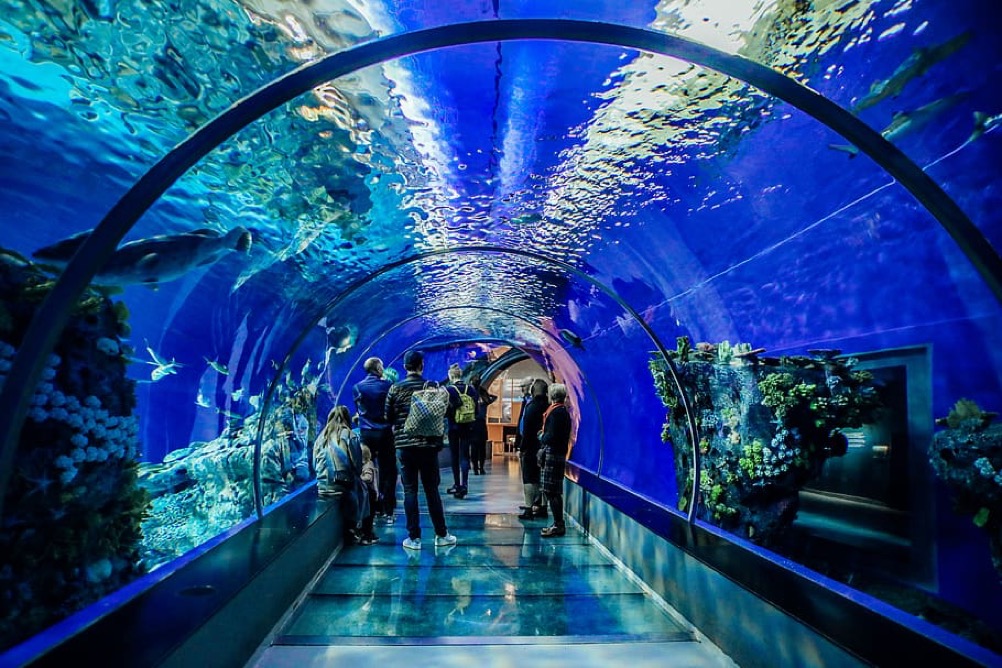
Now that we have more or less finished our 'tourist' visit, have you though about those unusual buildings that are so reminiscent fo sea waves?
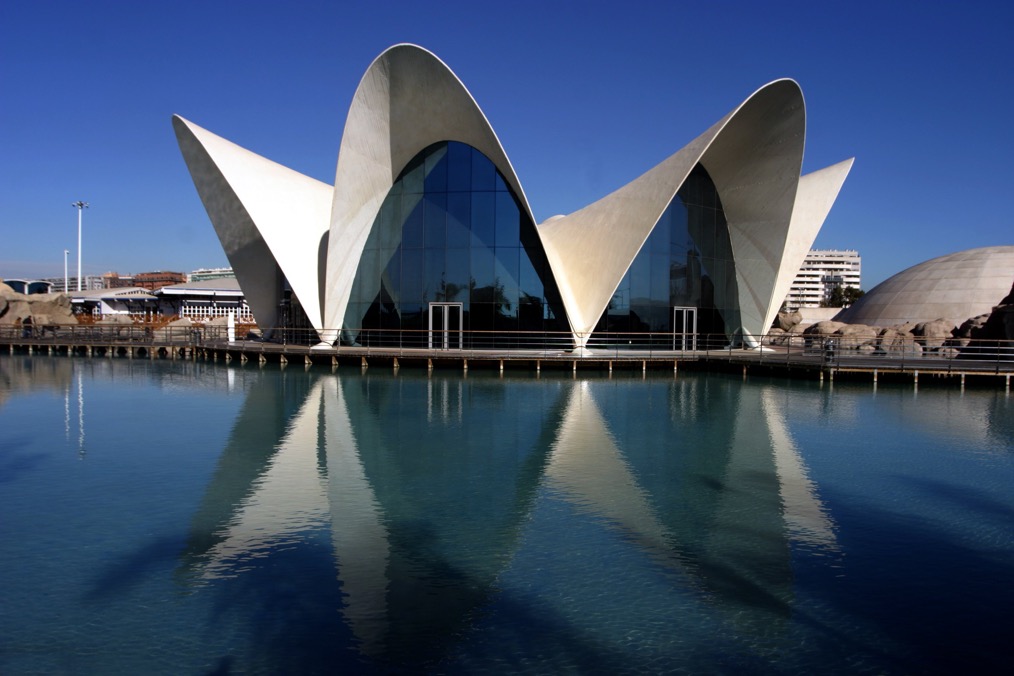
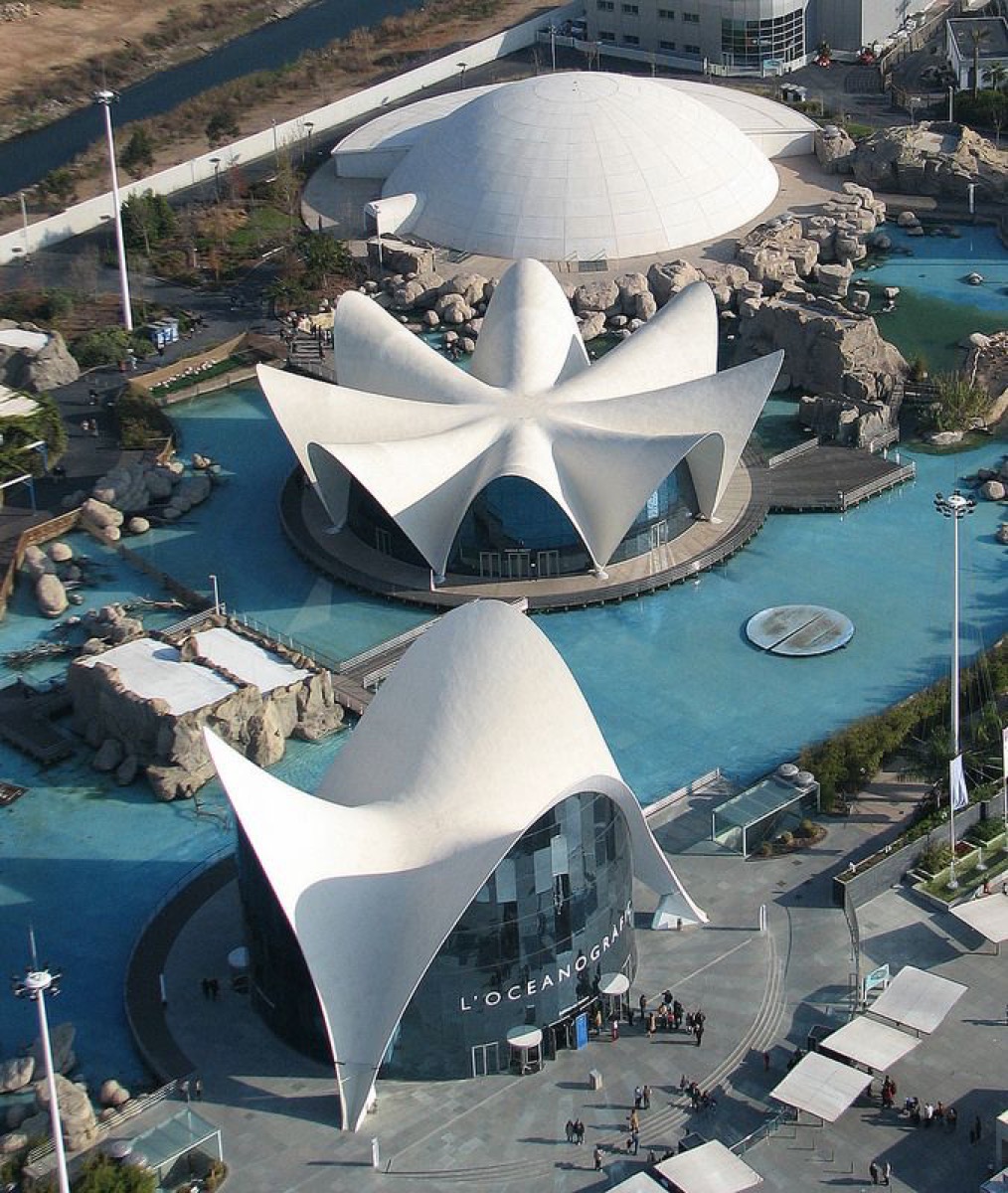
These prefabricate concrete shells are what Félix Candela was famous for. But what is a concrete shell? A shell structure is a building technique that exploits natural forces, shapes and force transfer to create 3-D structure that can span 30 to 40 metres while being only a few centimetres thick in the centre. This means that the structures are slender, don't require additional support, and save on materials. They are an application of what is called membrane forces (the Wikipedia article is a bit obtuse, so we will have to work around it).
Which would you prefer, a bent beam or an arch? Intuitively, we would think that an upward bent beam might be a bit better than a flat beam, but an arch would be even better. Now think of a flat plate, and an inverted bowl. The bowl is just a shell, which is just an arch in 3-dimensions). I think we would probably go with the shell as being stronger. And nature agrees, it's what we see in the vegetable, animal, and even mineral world. The reality is that a curved structure provides an improved resistance to loads for the same quantity of material. The reason is that the load is efficiently transferred to the ground, by compression, through the 'feet' of the shell (see the red in the model below).

If we look around we see shells being used to cover tennis courts, exhibition areas, aircraft hangars, etc. Shells can span metres with materials only a few centimetres thick.
It's not all positives, since shells are more difficult to make, and the shapes are pre-determined by the physics. The shells often require to be built in-situe on a metal frame, and the concrete needs to be poured manually and left to set for at least 28 days. So shells can be time consuming and effort intensive. Also you cannot put openings just anywhere, again the physics tells you what is possible and not possible, so design freedom is limited. Of course, the use of pre-fabricated shell sections can help reduce the time to build.
The most iconic building Ocenaogràfic is also the most representative of the technique, and its the Submarine Restaurant located on a concrete island in the middle of an artificial lake. Below we can see the site during construction, and the shell structure already in place.
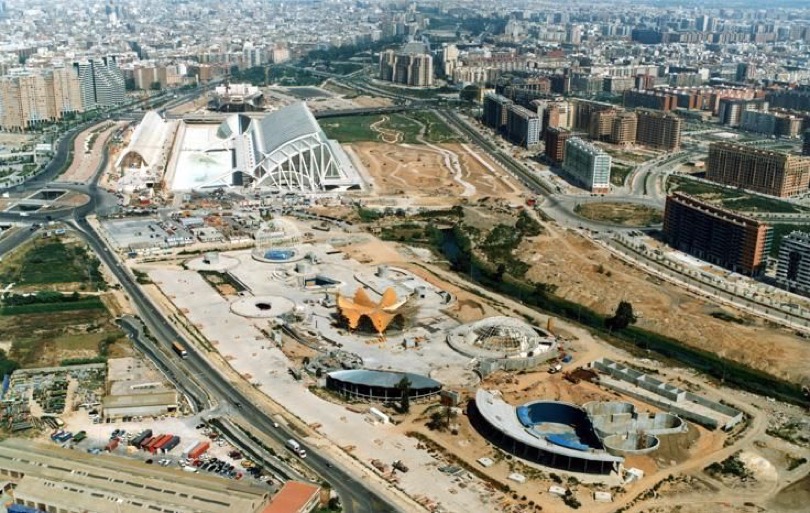

What we see is a so-called polar-array of a single shell designed on the basis of hyperbolic paraboloids, a three -dimensional structure that is optimal in resisting pressure-tension stresses, and in this case converting them in to compression along the legs.. We can see that it is possible to cover a large area (47 metres in diameter) with only 8 supporting legs. You can see that there are no internal supporting columns, and you can create a large empty space with curtain windows in each lobe. The shell from support to support is 36 metres, the height 13 metres and the thickness of the shell is in place only 8 millimetres, and never exceeds 60 millimetres.

What we see above is the finished shell, but the complexity lies in its construction, which took 200 days. On the foundations you need to construct a temporary structure that supports the general form that the roof will take. On this structure a formwork is built with long lumber planks (see below).
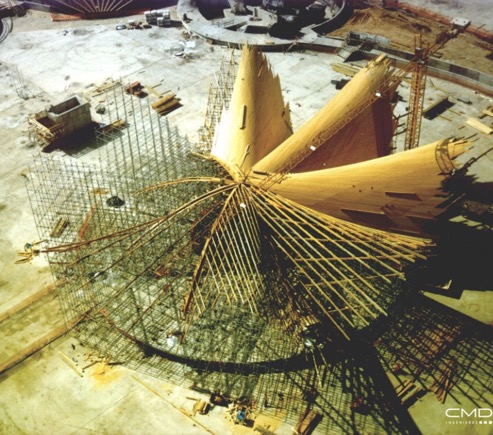
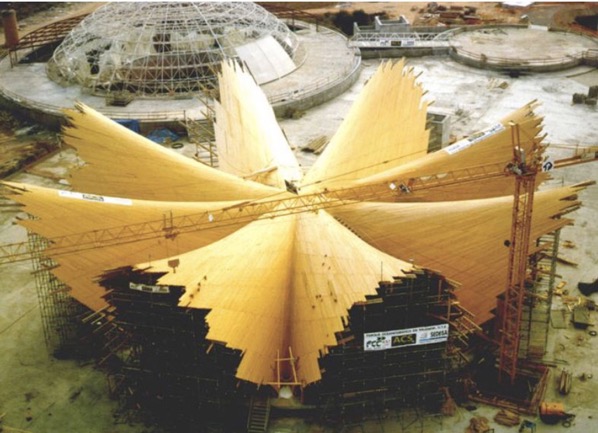
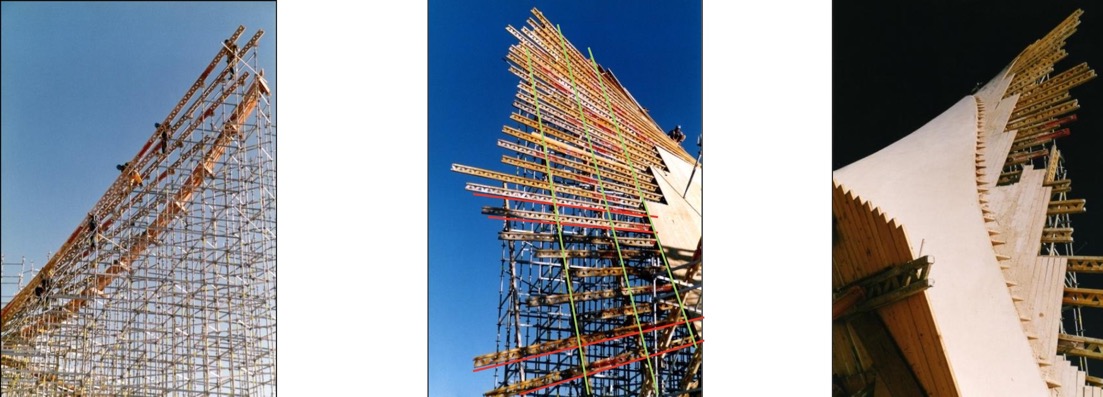
The entire wooden structure is covered in oil so that it can easily be released from the cement shell once built. Now that the shape has been fixed, a steel reinforcing is put in place. The concrete is shotcreted on to the framework, but this a long process that took 60 days. Then the concrete needs to dry for at least 28 days. Then the temporary framework snd formwork can come down, but it's a test because the shell structure is form-passive and any mistakes can cause it to collapse. So, as you can imagine, it is also a long and delicate process. Below we have a view of the entrance building, designed and built using the same technique.
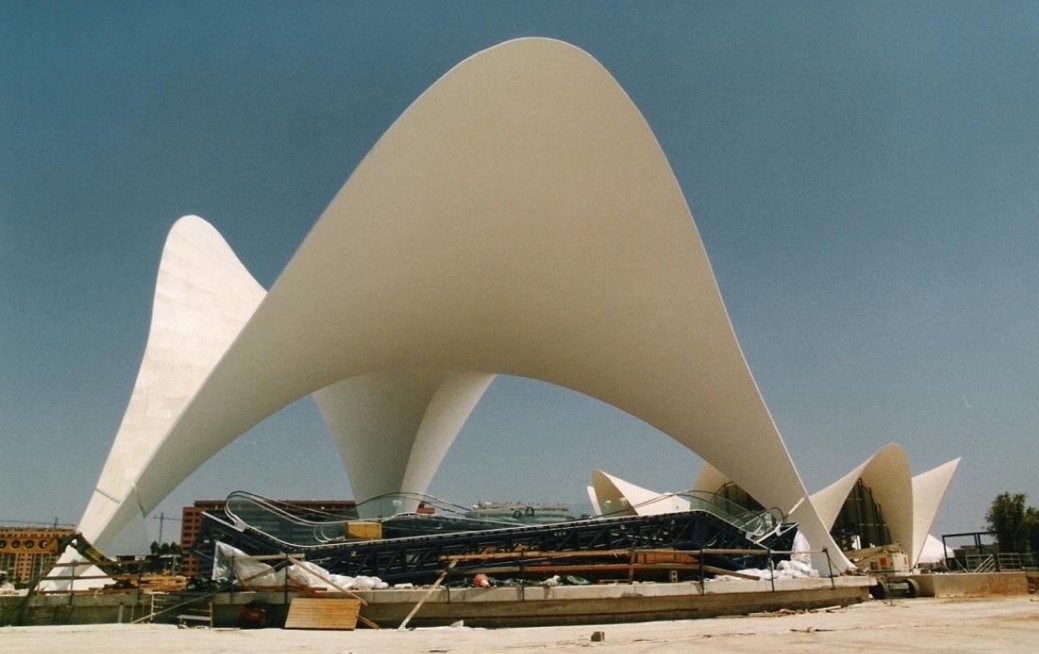
Ágora
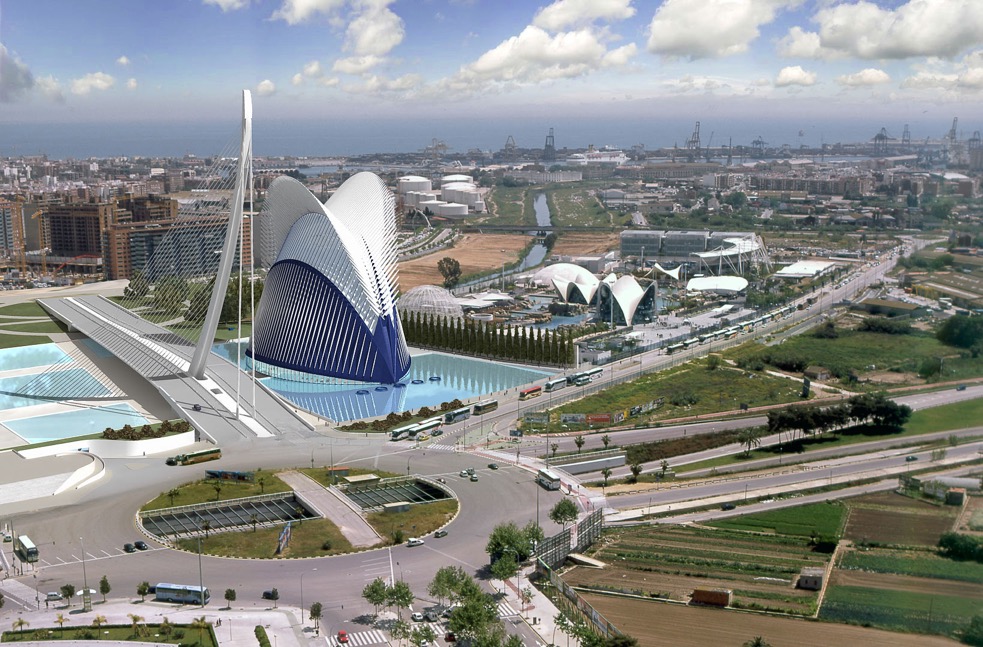
The Ágora is a large multi-functions space, also designed by Santiago Calatrava. It is the big blue building in the above photograph, and it was the last building to be finished. The building covers a surface area of 6,500 square metres, and is 80 metres high. The structure is metallic, but its covered by Valencian blue "trencadís" and glass, so a lot of natural light enters into the interior. The architect claims that it represents two intertwined hands.

The building, which was envisaged to be the 'final touch' to the site that has had its problems. It appears that it was never really finished, although it has occasionally been used. It was taken over, along with the Ocenaogràfic, by Avanqua (Aguas de Valencia), who prepared an audit report on each site (I think in 2015). There were a few minor problems with the oceanarium, but it was not the same for the Ágora. There were problems of leaks, humidity and rust, and as far as I understood things, they weren't prepared to take up the Ágora. The administration was even criticised for issuing a tender for the management of a building that can't be used.
In addition the roof was meant to open, but the pieces have never been installed (the pieces are in a nearby open field). You can spot the different between the computer generated first photograph and the real building just above, and you can see the missing white roof pieces. It was said that the total cost was €96 million, but according to Calatrava another €22 million was needed to repair and finish the building. In addition they have had to repair some of the "trencadís" that were cracked or chipped.
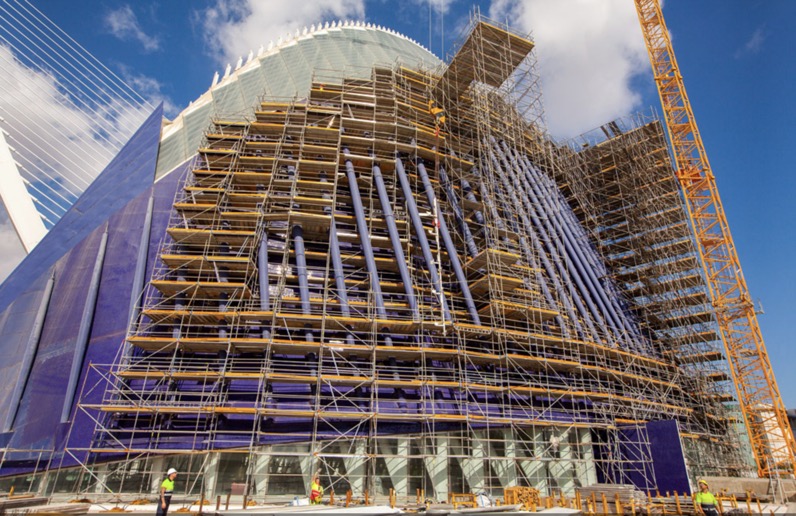
I think in 2018 the Caixa Foundation, linked to one of the Spanish banks, decided to invest €19 million (plus €5 million annually) in renovating the building and converting it into five independent internal zones for exhibitions, conferences, education, etc. I think part of this investment included the refurbishment of both the exterior and interior surfaces, representing more than the 4,300 square metres.
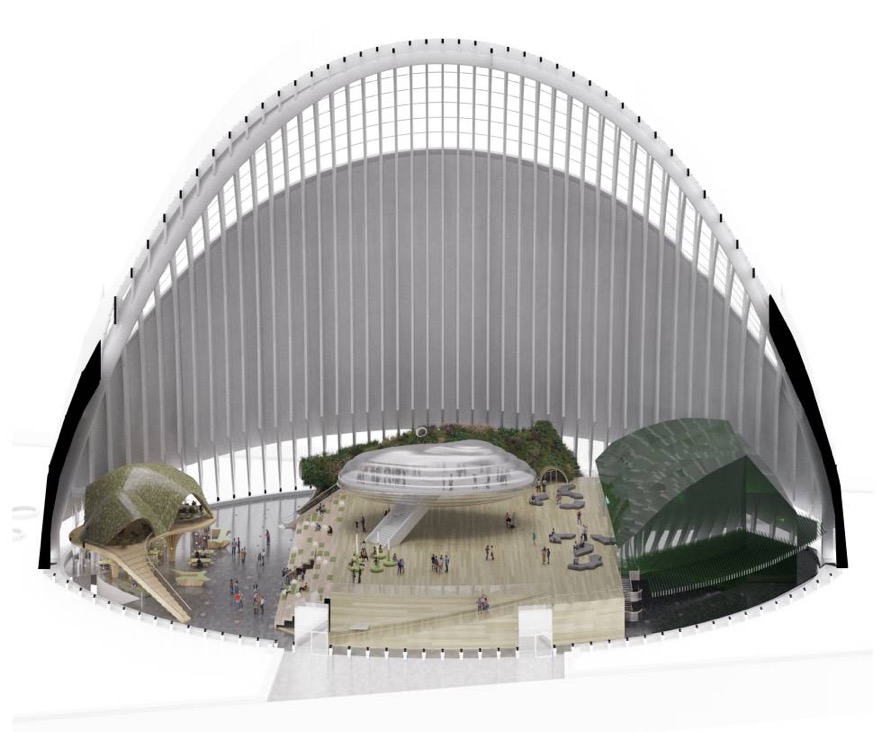
El Pont de l'Assut de l'Or
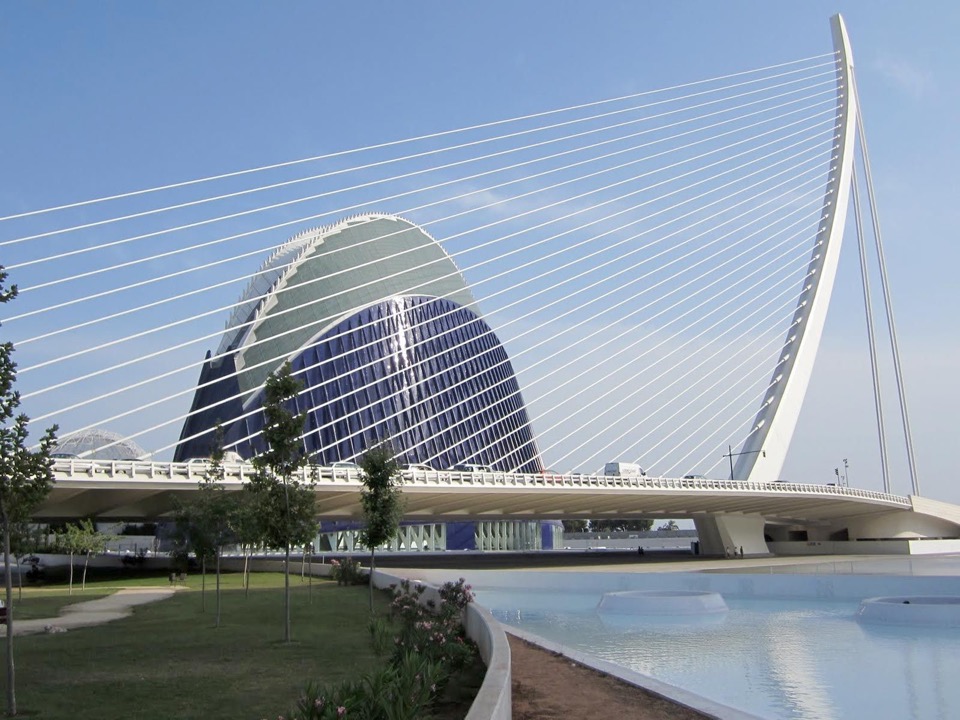
El Pont de l'Assut de l'Or is a white single-pylon cable-stayed bridge, again the work of Calatrava. What you see is a steel pylon, height 125 metres, leaning and with a curved geometry.
Cable-stayed bridges are quite common, but they usually have a more utilitarian look with more than one pylon, and spans that can easily exceed 700 metres. The uniqueness of this bridge is in its design and not it functionality.
This bridge has 29 main span cables, holding a steel orthotropic deck with a span of 160 metres. There are also 4 back span cables that connect the top of the pylon to the concrete counterweight. The deck is wide enough for three lanes each way, plus a tramway lane, and a middle lane for pedestrians and cycle traffic.
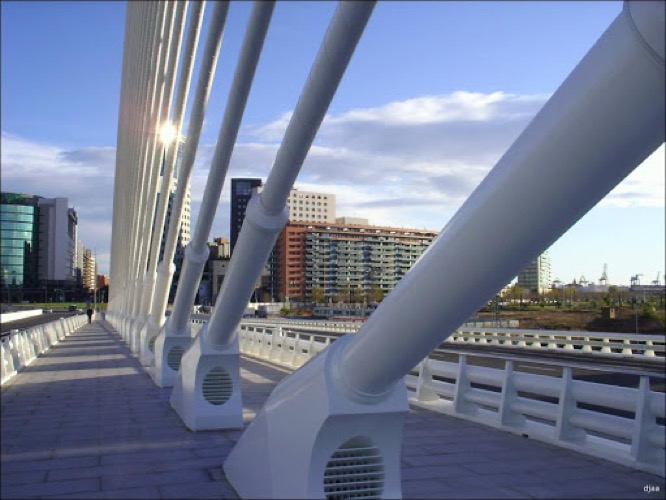
The foundation of the pylon consists of 20 piles, 43 metres deep and 2 metres in diameter, topped with a 6 metre thick pile cap. The counterweight sits in a hollow abutment and is a concrete block 40 metres, by 22.5 metres by 5 metres (i.e. I make that more than 11,000 tons).


The bridge itself is a box girder with cantilevered surfaces on each side, all made in steel. The pier and pylon, with the deck weight about 5,600 tons. Above we see how it was built.
The stays consist of bundles of wires. Each wire is 1.5 cm is diameter and each stay consists of between 31 and 61 wire stands, set inside a pipe (the pipe is ribbed to stop rain vibration). The back stays are made of 85 wire strands. Below we have the stay with the wire bundles, before being closed in the pipe.
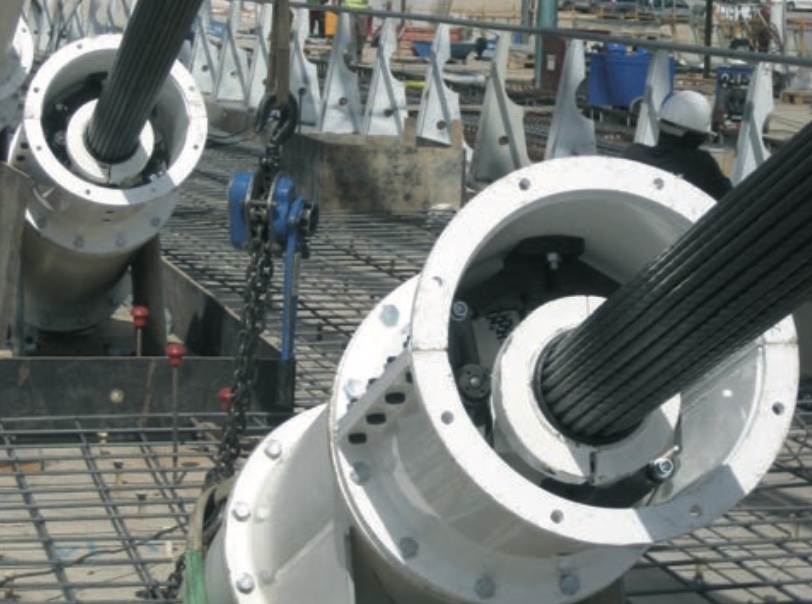
Below we can see the pylon being installed.
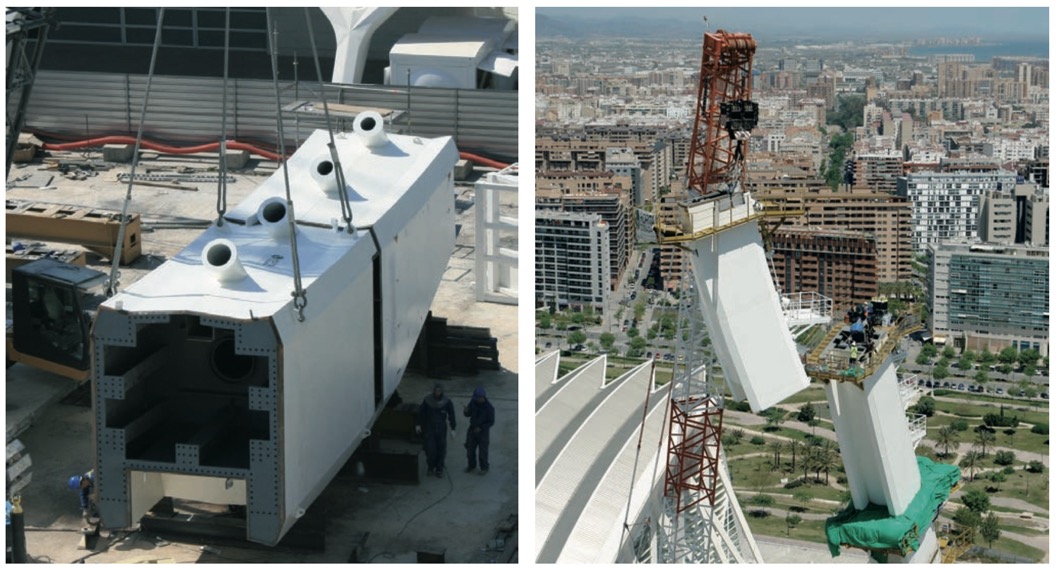
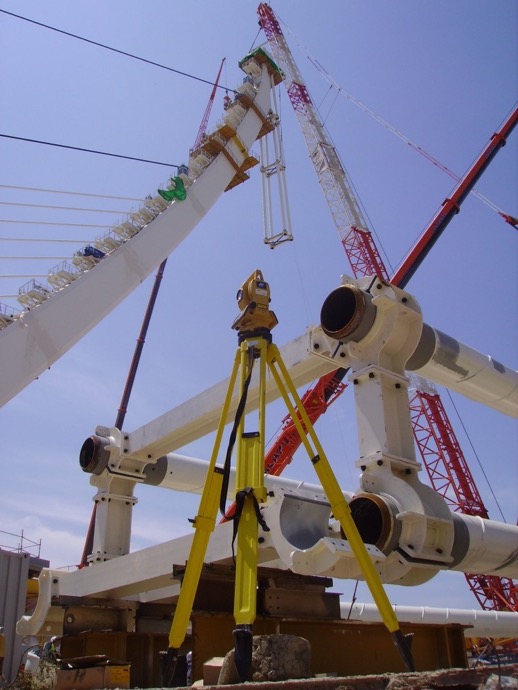
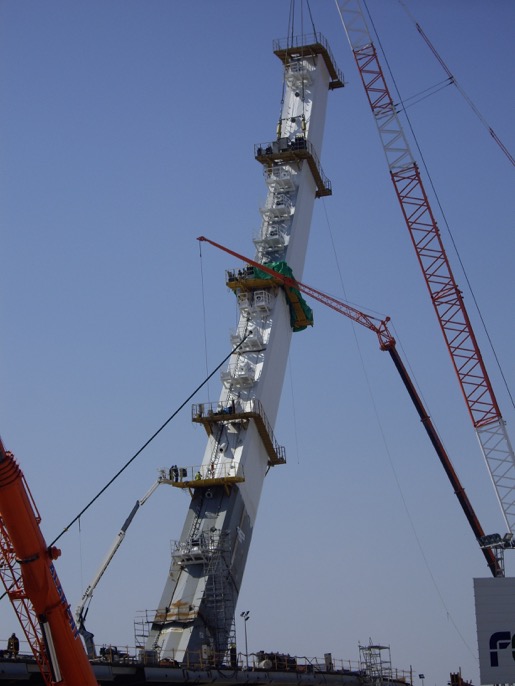
If you look carefully at the site you will see that there is also a second bridge called Pont de Montolivet, which was "adapted" by Calatrava. It is actually a double bridge that runs between the Palau de les Arts Reina Sofía and the Hemisfèric. The reality is that a bridge was already there, so he adapted it and included an aqueduct in its underpass. So it actually consists of two parts, the old bridge that crossed the northern part of the gardens, and the new bridge that crosses the southern part. Both bridges consist of two lanes, and are separated by a noticeable gap (there is a wide sidewalk and stair that allow people to go down to garden level). The older grey concrete bridge is more or less straight and flat, functional, and supported by two pillars and elongated arches. The new bridge is typical of Calatrava, made of white shiny concrete, it is slightly arched and supported on four slender pillars placed in the artificial lake.

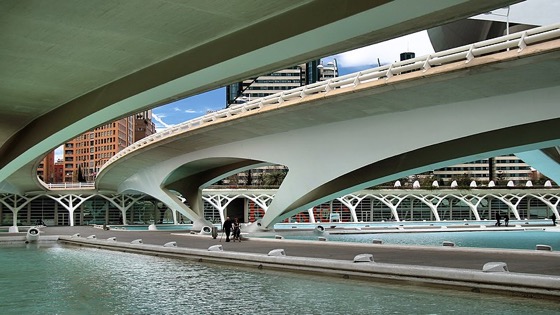
The Elephant in the Room
Some of the Spain press don't hesitate to mention València's "herd of white elephants".
Let's start with the really important figures:-
L'Hemisfèric (completed in 1998) - estimate €18.2 million - final cost €32.2 million
The Science Museum Principe Felipe (completed in 2000) - estimate €62 million - final cost €168.4 million
L'Umbracle (completed in 2001) - estimate €17.7 million - final cost €35.6 million
Palau de les Arts Reina Sofía (completed in 2005) - estimate €83.6 million - final cost €478.5 million
L'Oceanogràfic (completed in 2003) - estimate €38 million - final cost €201.4 million
L'Àgora (completed in 2009) - estimate €53.7 million - final cost €102.4 million
and El Pont de l'Assut de l'Or (completed in 2008) - estimate €23 million - final cost €59.9 million
Total site costs - estimate €296 million - final cost €1,078 million
Total investment by the city - estimate €308 million - final cost €1,282 million
A study concluded that for 2017 the City of Arts and Sciences generated €133.5 million for the city's economy and supported 3,461 jobs. Spending by tourists was estimated at €120.4 million. The Oceanogràfic was the most popular, generating €32.5 million and supporting 1,360 jobs. The study also estimated (pre-COVID) that the benefit would grow by 2.2% annually, and would have a positive impact on hotel room occupancy and prices, and on real estate prices. Tourists were asked about the importance of the City of Arts and Sciences, and ⅔ of them concluded that it was "enough to very important" in deciding their destination. The study concluded by estimating that more than 50% of the 2.7 million visitors to the city annually will visit the Oceanogràfic, and more than 25% will visit the Museum.
The reality is that after 2008 the property boom exploded leaving Spain in an economic shambles. Unfinished building sites and empty homes could be seen everywhere. More than 1 million excess properties were on the market. Municipalities had spent modernising infrastructure and subsidising business zones, but also in grandiose public buildings designed by "starchitects". They found themselves with stalled projects and enormous public debts.
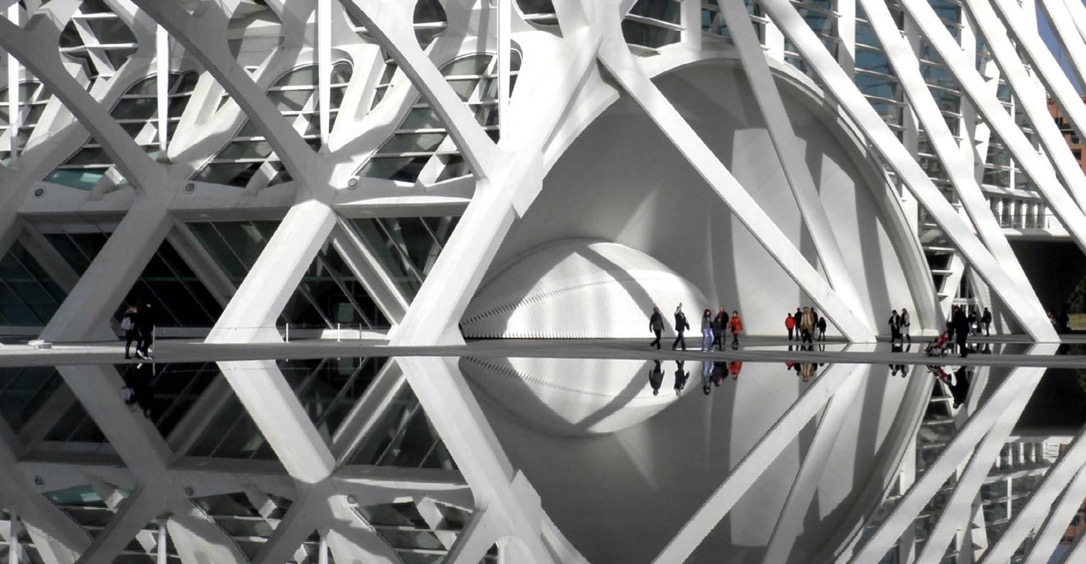
What looked like masterpieces of architecture suddenly became symbols of economic folly or even political arrogance. In peoples minds construction projects now meant money wasted and debts that could not be reimbursed. In València, the City of Arts and Sciences went from being an acclaimed new landmark to a loathsome reminder of the city's debt and mismanagement. Peoples opinions rapidly changed from admiring symbols of civic pride to seeing just reminders of senseless extravagance.
It's nice to read studies suggesting that the debt incurred in building the City of Arts and Sciences wasn't that bad, and there is even a hint of a silver lining. But unemployment in València is around 17% (pre-COVID) and the average wage is around €29,000 annually. The Comunidad Valenciana debt is the around €10,000 per inhabitant (42% of its GDP).
It's up to each person to decide if the buildings shown here are examples of fantastic architecture and are long-term assets to the city, or are more than anything else examples of senseless arrogance and mismanagement, or simply should never have been built.